You are using an outdated browser. Please upgrade your browser or activate Google Chrome Frame to improve your experience.


Yacht Water Damage: Can It Happen To You?
Whether you enjoy cruising the ocean blue, relaxing on sunny weekends, or taking a boating trip every summer, your yacht is important to you, so you need to know how to take care of it and what to look out for that indicates yacht water damage in need of professional attention.
A few signs of potential yacht water damage include:
- minor blistering or bubbling of surfaces in the structure of the yacht
- excessive mildew odor inside or on deck
- salty buildup on surfaces inside
Your yacht is important to you- always be on the lookout for water damage.
If you suspect your yacht has been water damaged, don’t turn anything on and don’t try to fix or clean anything yourself as this can cause more harm than good. Call a professional like those at SERVPRO Ft. Lauderdale North and SERVPRO Plantation (or for your local SERVPRO team call 1-800-SERVPRO). Once you identify and possibly fix the cause of the water intrusion- which can include:
-a SERVPRO team can get started on cleaning any upholstery, decks, walls, and anything else infiltrated by water.
Ocean water and even brackish water, like that in the intercoastal, are particularly difficult to remediate due to the salt content and should be left to your SERVPRO team. The sooner you get a team to your yacht, the less salt damage will occur. Salt will corrode important seals, joints, and mechanical components if left unfixed for too long.
Call SERVPRO Ft. Lauderdale North or SERVPRO Plantation for all your yacht cleaning needs. Faster to any yacht water damage disaster SERVPRO Ft. Lauderdale North and SERVPRO Plantation will make it like it never even happened.
For more information on the SERVPRO Ft. Lauderdale North and SERVPRO Plantation owner Tyrone Po, click here .
Leave a Reply Cancel reply
Your email address will not be published. Required fields are marked *
- Bottom Painting & Prop Speed
- Fiberglass & Paint Work
- Running Gear & Valves
- Full-Service Team
- Monthly Maintenance Programs
- Dockside Service Team
- Full-Service Boatyard
- Management Services
- Accounting & Reporting
- Relevant Management Experience
- News and Media
Ways to Prevent Boat Water Damage

Boat water damage can occur through various mechanisms, including the devastating force of hurricanes and more common scenarios. During hurricanes, intense winds and torrential rains can breach seals, hatches, or covers, allowing water to infiltrate the interior. Other factors to consider are powerful waves and storm surges can submerge vessels, causing extensive damage. In everyday situations, rainwater, leaks from fittings, or improperly sealed openings can seep into a boat, gradually accumulating and compromising its structural integrity.
Just because this is possible doesn’t mean you have to accept that it simply will happen. The team at Yacht Management South Florida, Inc. understands the importance of keeping your boat water damage to a minimum more than most yacht management companies. To explain how they accomplish this, they provide their insights in this article. Here you will learn about what water damage can do to your vessel and how our team can help keep your yacht in working order.
What Could Happen in a Water-Damaged Yacht?
It is important to illuminate the potential ramifications of water damage on a yacht, shedding light on the intricate consequences that water damage yacht owners experience if they are not on top of all necessary maintenance. The effects of water damage to a boat ripple through various dimensions, driving home the imperative of preventive measures and diligent maintenance within the maritime domain.
- Structural vulnerability : Boat water damage infiltrating a vessel can compromise its structural integrity, posing safety concerns that necessitate timely intervention.
- Electrical panel intrusion : Water in the electrical panel emerges as a significant issue, disrupting critical electrical systems and raising potential hazards.
- Aesthetic and functional deterioration : The aftermath of water damage extends to upholstery, interiors, and mechanical components, eroding aesthetics and functionality.
- Navigational and safety impairment : Yachts encountering water damage may experience corrosion in navigational equipment and safety systems, imperiling both crew and passengers.
- Economic strain : Addressing water damage on boats engenders financial strain, encompassing repair costs and potential loss of revenue due to downtime.
- Diminished resale value : Yachts grappling with water damage often face diminished resale value, reflecting the compromise in both appearance and condition.
- Operational disruption : The extensive repairs demanded by water damage disrupt planned voyages, causing operational inconvenience.
- Environmental concerns : Water damage can introduce hazardous substances into the environment, impacting marine ecosystems and sustainability initiatives.
Comprehending the intricacies of water damage underscores the need for proactive mitigation strategies, adherence to safety protocols, and regular assessments. Our expert South Florida yacht management providers advocate for an enlightened approach. We emphasize the preservation of your yacht's longevity, value, and the well-being of all who navigate its waters. There are many ways that we do this. One way our team can help with boat water damage is by providing services that prevent yacht damage .
Services for Yachting Protection in South Florida
Water damage is a formidable adversary capable of jeopardizing the integrity and safety of yachts. At Yacht Management South Florida, Inc., we're steadfast in our commitment to providing comprehensive yacht protection through an array of preventive services. These services, spanning from hurricane preparation and readiness to bottom cleaning and zinc replacement to encompassing meticulous fiberglass and paint work, collectively fortify your vessel against the perils of boat water damage.
- Hurricane preparation and readiness : Our rigorous hurricane preparation measures extend the shield of boat protection from the forces of nature, which can be one of the most disastrous things that can happen to a boat. By meticulously securing your yacht, fortifying docking systems, and adhering to comprehensive checklists, we minimize the vulnerability of your vessel, safeguarding it against potential water damage even in the face of hurricane-damaged yacht scenarios.
- Bottom cleaning and zinc replacement : Shielding your vessel from water damage is paramount, and applying bottom paint stands as a pivotal step. In South Florida's saltwater milieu, protection is imperative. With decades of expertise, our seasoned bottom paint team safeguards over 350 boats annually, achieving a flawless satisfaction rate. Our meticulous approach and unmatched service encompass ablative, hard, and copper-free paints, along with prop speed coatings for underwater metals. Sandblasting, blister repair, and using environmentally friendly clear antifouling hull coating from Hull Maxx are also within our repertoire. Fortify your boat against water damage with our proven excellence and comprehensive offerings.
- Fiberglass and paintwork : Our boatyard boasts a team of meticulously selected and skilled marine craftsmen, primed to be your frontline defense against water damage. Proficient in comprehensive fiberglass repair work and restorations, their expertise acts as a robust barrier, thwarting potential sources of water intrusion. Complementing this, our painting team employs premier boat paints and finishes, enhancing your yacht's resilience against water-related threats.
As you embark on your maritime pursuits, integrating these preventive measures into your yacht management strategy fortifies not only your vessel but also your peace of mind. Yacht Management South Florida, Inc. stands as your stalwart partner, arming you with the tools and insights to shield your investment from boat water damage and ensure a safe and gratifying yachting experience.
Get in Touch with Our Fort Lauderdale Yacht Management Team
Unveil the expanse of our comprehensive yacht management services, meticulously orchestrated by our Fort Lauderdale-based experts. Doing this can protect your yacht from boat water damage in a typical situation or during hurricane conditions. Whether you're seeking marine engine maintenance or holistic superyacht care, a swift call links you to our adept team.
Engage with our Fort Lauderdale yacht management specialists to access an expansive array of services promising triumph and unwavering assurance in your investment's enduring worth. Our esteemed South Florida yacht management unit curates an extensive reservoir of illuminating yacht management blog articles . Crafted for clients and curious boaters alike, these articles encompass diverse yachting themes, enriching your grasp of yacht care and ensuring you remain informed about industry strides. Immerse yourself in these thoughtfully sculpted gems to deepen your knowledge and stay current.
For inquiries or to embark on an exploration of our services, our marine maintenance experts eagerly stand by. Yacht Management South Florida, Inc. remains steadfast in guiding you through yachting's intricate tapestry with dedicated expertise. Reach out today to connect with our marine maintenance specialists and elevate your maritime journey.
Related Readings
- Getting Your Yacht Summer Ready
- How Often Should You Get a Boat Bottom Cleaning?

For all inquiries, fill out the form below and a member of our team will respond as soon as possible
Carpet Cleaning
Upholstery Cleaning
Dry Cleaning
Mattress Cleaning
Marble Cleaning & Polishing
Curtains Cleaning
Overhead Cleaning
Leather & Suede Cleaning
Vinyl Cleaning & Restoration
Wood restoration & Refinishing
Bathrobes & Towels
Carpet Installation & Repairs
Fireproofing & Retardant
Free Pickup & Delivery
Rug & Oriental Cleaning
Awning Cleaning
Bed Covers & Blankets
Boat Cover Cleaning
Carpet & Floor Runners
Exterior Cleaning & Detail
Interior Cleaning & Detail
Exterior Cushion Cleaning
Linens & Sheets
Canvas & Upholstery Fabrication
Outdoor Furniture Cleaning
Ozone Treatment
Tablecloths & Napkins
Umbrella & Canvas Cleaning
Water Damage & Flood Restoration
Yacht Wear & Uniforms
Wet Cleaning
Yacht Water Damage and Flood Restoration
Icon Yacht Care is there to help you in any type of emergency including any Yacht Water Damage and Flood Restoration you may need. With two decades of experience, our team has dealt with all types of emergency situations and we are there by your side at a short notice to ensure the damage gets taken care of before it worsens. Just as a house is susceptible to floods, and malfunctioning with air condition, plumbing and leakages, so is a large yacht. These accidents are often inevitable and can cause further damage if not taken care of right away. As the owner of the boat, captain, first officer, stewardess or crewman, you need to take control of the situation immediately by getting a fast water extraction and eventual restoration of anything that was damaged. At Icon Yacht Care, we know these things happen often without the slightest warning and it’s why we are here to help. As a full-service yacht care team, we specialize in multiple aspects including water damage and flood restoration. Water is a powerful element and can saturate furniture, drapes, carpets, vinyl and fabric wall coverings, wood and other surfaces leaving the interior of your boat look unappealing and in need of a makeover.
Our team is on call to assist in emergency extraction and drying, yacht cleaning, cleaning of the upholstery and carpet, flood restoration, and ozone treatments to remove any foul odor left behind. Our team at Icon Yacht Care are professionals when it comes to Yacht Water Damage and Flood Restoration which is why we take these matters very seriously. The investment of owning or running a yacht is expensive, why add to those costs by waiting too long to restore the damage. Leave it up to our team to come and assess the situation beforehand and offer you a free estimate before anything is done. We strive to keep our customers happy and the yacht life alive so do not hesitate to give us a call today.
This function has been disabled for Yacht Cleaning and Fabrication Services .

- Schedule a service
- Our Customers
- X We invite you to check our customer reviews. Testimonials

- Carpet Cleaning
- Upholstery Cleaning
- Dry Cleaning
- Wet Cleaning
- Bed Covers and Blankets
- Linens and Sheets
- Carpet Runners Cleaning
- Area Rug Cleaning
- Outdoor Furniture
- Mattress Cleaning
- Marble Cleaning & Polishing
- Curtains Cleaning
- Overhead Cleaning
- Leather & Suede Cleaning
- Vinyl Cleaning & Restoration
- Wood Restoration Refinishing
- Table Cloths and Napkins
- Bathrobes and Towels
- Boat Covers Cleaning
- Tender Covers Cleaning
- Carpet & Upholstery Repairs
- Vinyl & Canvas Repairs
- Exterior Cleaning & Detailing
- Interior Cleaning
Water & Flood Restoration
- Ozone Treatment
- Free Pick Up & Delivery
- Environmentally Green & Eco Friendly
As a yacht owner, captain, first officer or chief stewardess you understand that your vessel is at risk of floods from mechanical failures, air conditioning malfunctions, plumbing problems, and occasionally even leaks from heavy rains. When you find yourself in this situation, you need fast water extraction and water damage restoration services. Water can saturate furniture, drapes, carpets, vinyl and fabric wallcoverings, wood, and other surfaces in a flash and leave you with water damage. Restoration services from a Mega Yacht Cleaning, professional yachts cleaners , feature emergency extraction and drying, yacht cleaning, cleaning of upholstery and carpet, flood restoration, and ozone treatments to eliminate musty odors.
Mega Yacht Cleaning Offers Full Service Restoration
Mega Yacht Cleaning, a full-service yacht cleaning company , handles the whole process of restoring, cleaning, sanitizing, and purifying the air in your yacht. Available 24/7, we are always ready to respond to your need for water extraction emergency services.
- Soaked carpet? Flood restoration services may be able to salvage it if you act fast enough. If not, we can install new floor coverings.
- Damaged upholstery ? Water or flood damage can be devastating if the upholstery is not quickly and professionally dried. We will assess whether cleaning can help or whether you need to replace soaked furniture, mattresses, bedding, and other fabric surfaces.
- Buckled wood on floors, ceilings, or walls? We will restore what we can and replace water logged sections.
- Poor air quality? Our ozone treatments will remove residual mold spores and smells that remain in the air.
For immediate response after water damage, call Mega Yacht Cleaning at (954) 448-8899 . We offer free estimates, competitive prices, and friendly service that will get your vessel back on the water in no time.
Licensed & Marine Insured
Mega Yacht Dry Cleaning & Laundry
Providing fine fabrics, carpets and stone care for yachts and boats. Our specialty services include dry cleaning, laundry, carpet cleaning, upholstery cleaning, mattress cleaning, curtains cleaning, marble and granite cleaning. All of our services come with free pickup and delivery anywhere in South Florida.
No job is too small or too big, we can accommodate our schedule to your needs. With 15 years of experience in the dry cleaning and laundry industry your satisfaction is guaranteed as well as our attention to details and personal service that compares to no other.
So give us a call… and let us show you what makes us different.
954-448-8899
- Miami Beach
- Fisher Island
- Key Biscayne
- Coconut Grove
- Coral Gables
- Fort Lauderdale
- Pompano Beach
- Lighthouse Point
- West Palm Beach
- Broward County
- Dania Beach
Newsletters

- Cruising Compass Media Advertising & Rates
- Blue Water Sailing
- Multihulls Today
- Subscribe Today

How to Assess and Repair Fiberglass Damage
By John Champion, published in BWS May 2015
There are many types of materials used to build boats these days and have been for a long time—wood, steel, alloy and for a while, ferro cement. However, the vast majority of production boats are now made of fiberglass, either glass reinforced plastic or GRP. The “miracle material” of fiberglass was widely hailed as a maintenance free boat building opportunity in the 50s and 60s and has progressed—with some marked improvements and significant failures—ever since.
Today, production yachts are being seen more and more frequently in remote and popular cruising grounds that are a long way from their homeports. Yachts built by Beneteau, Jeanneau, Catalina, Bavaria and Hunter, to name a few of the larger builders, are crossing oceans and providing long term homes for an increasing number of people who opt for the sailing life. Not too long ago many of these fiberglass boats were routinely scorned and rejected as utterly unsuitable for cruising, never mind an ocean crossing or circumnavigation. But based on the number of old plastic tubs (term of endearment, as I’ve lived on one or another for 15 years) that I see arriving daily from all over the globe, this is not the case anymore.
Logically it would seem that older boats represent an attractive price point and allow more people to make the move aboard and go cruising. The long shelf life of GRP construction means that vast numbers of older production boats are available; coupled with the many thousands of annual new yacht launches and the competitive nature of the production boat industry keeping new prices down means real bargains in used boats abound. This encourages those considering an early retirement or extended sabbatical to go cruising now.
Even though we can get a GRP production boat that is largely equipped for our needs, we need to ask and answer a few questions: Are all production boats equal? And is all GRP construction equal? The short answer to both is no. So to understand our production boat better and to make a more informed decision, we can examine a few mainstream build methods and materials.
THE MATRIX No, Keanu Reeves does not build boats to my knowledge; this matrix refers to the construction of the hull. Usually glass fibers and resin, a core (more on that later) may be used but typically glass fiber in various weights and numerous weaves are impregnated with resin within a gel-coated mold to form the basic hull. It is the nature of the fibers—combined with factors such as thickness and reinforcing—that determine the structural characteristics of the hull.
Essentially the resin does nothing but protect the fibers from water, sun, chemicals and other potentially degrading sources. Resin is not our friend as it is heavy and brittle, with little inherent strength. The best lay-ups have a low resin to fiber ratio; 40/60 percent respectively is regarded as good but many sources believe 60/40 is more like the typical reality. This ratio will largely depend on the skill, dedication and care factor of the people who do the work. Design and management plays a big part of course, but all the engineers and managers in the world will not make a badly hung over and sleepless Fritz, Francois or Frank do the best job on this particular morning.
Unless infusion technology is used (fibers are laid up, sealed, a vacuum is applied and the optimum quantity of mixed resin is then sucked in and dispersed through the fibers), then we are dependent on our chosen company’s work force to achieve the designer’s objectives. Too much resin means more weight and lower strength, too little resin means dry fibers and the likelihood that these fibers will absorb water over the years and encourage blisters and/or delamination. So it is a fine line the production builder walks, although according to the brochures and websites each has it down pat.
Of the common fibers used in a layup, chopped strand mat is arguably the most popular. Easy to wet out and work with, it is cheap and is therefore frequently used to provide thickness to a layup and prevent visible “print through” from other fibers such as rovings—larger strands or bundles of fiber running in various directions. This thickness is required to produce stiffness in the hull. Chopped strand mat consists of short fibers randomly oriented and held together with a binder. This creates a layer that has equal strength in all directions but is less strong than larger fibers oriented inline with the anticipated load, which is where the engineers make a difference.
In essence, the fibers are the strength and the resin just holds them together. Too thin and flex is introduced, which is not particularly desirable in a hull. This is why core products have been developed.
CORE VALUES Core technology has been around for quite some time, which makes it highly unusual not to find a production boat without a cored deck. If you do, it will probably be quite apparent because you will feel the deck flex underfoot as you walk around. Plywood (hopefully marine ply) is frequently used to build a deck. The wood provides immediate thickness that is required to impart stiffness to a structure. This is a tried and true procedure that if properly done will provide a very long service life. Properly done is the key point.
Ideally where fittings will penetrate the deck—winch bolts, travelers, jib tracks, cleats and windlasses—the ply will be replaced at the factory with a solid glass layup or aluminum alloy insert. The alloy insert can then be tapped to allow fittings to be secured with machine screws and not through-bolted. This is popular with jib tracks and travelers. If the ply remains as it sometimes does, then when or if the sealant around the bolts fails, water will begin to find a way into the timber core. Good marine ply will resist this but will eventually begin to break down and cause the damage to spread. Spongy sections are the result, with a real risk of the fitting eventually pulling out in exciting circumstances—imagine that big genoa winch flying out of the deck when you are sheeting it on and you’ll know what I mean.
So decks have been cored for a long time and increasingly hull cores are also being used. Some builders have used cored topsides for quite some time; Bavaria has been using core materials above the waterline and solid GRP below for years. The benefits of core material in boats is plain, lighter weight, increased stiffness, better insulation and one would imagine less expensive in material, labor or both. Otherwise price point-conscious builders would not be using it. A number of high volume manufacturers who previously made solid GRP boats now produce cored hulls. Marlow Hunter is one example.
The downsides are equally apparent, less compressive strength and the potential for nasty problems like shearing—when the internal or external GRP skins part from the core—or water ingress that may compromise the hull to a greater or lesser extent. The strength of the core is directly related to the bond of the two skins to the core material, if this fails then there are two or three independent structures, not a single sandwich to bear the loads. All core materials are not equal and there are many products around that claim to be impervious to water ingress or of closed cell structure that will not allow water to spread to other areas.
Balsa has long been used as a core material and typically is supplied in small blocks that are about the size of a matchbox attached to a web like material—very similar to a sheet of ceramic tiles and all the blocks have a gap between them just like the tiles. The reasoning here is that GRP is applied between every block, which essentially encapsulates the individual blocks. If damage occurs that allows water into a block, it is trapped by the surrounding GRP and theoretically cannot migrate further. If poorly done, water will travel relatively freely and the core will rot; if damage is extensive, repair costs may exceed the value of the boat.
Balsa has good compressive strength and makes a good stiffening medium as demonstrated by Catalina with the 460 model in the mid 2000s. This hull had the solid GRP layup schedule of the 400 model but had balsa core added inboard on the topsides for additional stiffness. Many of the PVC and foam cores available also use the “tile” principle, which also assists in shaping the layup to curves but some do not and rely on the ability of the material to prevent water migration if it does find a way in.
More high tech boats, usually of the go fast variety, will use a lightweight core throughout the hull, both above and below the waterline. Impact resistance is lessened and exotic fibers such as Kevlar may be added as reinforcement. Kevlar has very good impact resistance and is difficult to penetrate. Jeanneau has been marketing “Kevlar energized” in their hulls for years and Hunter for quite a while also. Catamaran performance depends a lot on limiting the amount of weight, hence they perhaps benefit more from cored construction than any other type of cruising boat. Core material in boat furniture can also significantly reduce weight.
DAMAGE So you are considering a boat with a cored hull but there seems to be damage—what to do? Well the good news is that it can be fixed, but can you afford it? The biggest concern is the extent of the condition. Naturally a small amount of damage, identified early will not be an insurmountable problem. Essentially the process is to remove the damaged area, dry it if required and replace the material. This is easy if it is six inches of accessible deck, but is a massive undertaking if the damage is half of the hull.
For vessels with a large area of compromised core, a common owner’s fix has been to drill hundreds of holes in the affected area and dry it out as much as possible, which depends entirely on the people affecting the repair. When dry, the holes are then filled with a very thin epoxy so it can travel as the water had in the expectation that it will fill the voids in the laminate.
You are then left with these holes to fill, which will always be visible unless a full respray of the hull or deck is undertaken. The wisdom that “new paint hides many sins” sums this up, which is why many people are afraid of fresh paint jobs on boats that have just been put up for sale. A known cored hull can be closely inspected for damage or indications of compromise but can be hard to spot especially if the damage is manifest internally and may be concealed by furniture. Percussion testing and moisture meters are an imperfect science. Of course there is a whole lot more to building a decent hull than this and a million variables for the builder to consider. Curious souls could get a copy of Fiberglass Boats by Hugo Du Plessis.
DECK FITTINGS A good practice for installing or maintaining fittings on cores or even solid GRP (this will also degrade over the years if water gets in) is to drill oversized holes for the fasteners and fill them with marine epoxy such as West System with adhesive suitable micro fibers. Once this has gone off properly, the correct sized holes for the fasteners can be drilled and the bolts sealed with the appropriate sealant. This means the precious core is isolated from the holes and will remain dry even if the sealant does leak down the track. Many core materials (particularly foam types) are not at the best under compression and can crush under the force of the tightened bolts; backing plates or the largest washers practical are preferred to spread the compressive load.
John currently floats around in Langkawi, Malaysia and offers appraisals and surveys for production boats in the region. www.championmarinesurveyors.com
If you are thinking of buying in Asia he can be contacted at, [email protected] .

Administrator
You might also like.
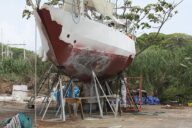
Problems with Paint Application Q & A

Dinghy Security
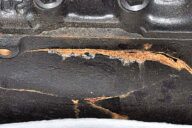
Winterizing Your Engine

Read the Summer-Fall Edition of Blue Water Sailing
Read the fall 2023 edition of blue water sailing, recent posts.

- Survey of the Week

- Introducing the New Dufour 44 Modern Family Cruiser
Please Visit Our Sponsor’s Webpages

- Media Advertising & Rates
Published by Blue Water Sailing Media, a division of Day Communications, Inc., Middletown, RI
Publisher & Editor: George Day
Blue Water Sailing Media publishes Blue Water Sailing magazine, Multihulls Today and other titles.
Cruising Compass Advertising Sales:
George Day, Newport, RI [email protected] 401-847-7612
- Cruisers Rescue Frantic Castaways off French Coast
- The 37th America’s Cup Defense Begins in August: Here are the Important Dates
- A Guide to 10 Great Blue Water Boats
© 2014 Blue Water Media. All rights reserved. | Admin
Boat Reviews
- Aquila Boat Reviews
- Aspen Boat Reviews
- Avalon Boat Reviews
- Aviara Boat Reviews
- Axopar Boat Reviews
- Barletta Boat Reviews
- Bayliner Boat Reviews
- Centurion Boat Reviews
- Charger Boat Reviews
- Cruiser Yachts Reviews
- Formula Boat Reviews
- Fountaine Pajot Reviews
- Freeman Boatworks Reviews
- Galeon Luxury Yachts Reviews
- Intrepid Boat Reviews
- Jupiter Marine Reviews
- Manitou Boat Reviews
- Native Watercraft Reviews
- Phenom Yacht Reviews
- Pursuit Boat Reviews
- Sailfish Boat Reviews
- Sea Ray Boat Reviews
- Sea-Doo Watercraft Reviews
- SeaVee Boat Reviews
- Solace Boat Reviews
- Windy Boat Reviews
- X Shore Boat Reviews
- Yamaha Boat Reviews
- Boats Specs
- Marine Pros
- Boat Insurance
- Boat Warranties
- Boat Transport
- Boat Towing
- Marine Forecasts

Your Ultimate Boating Resource

2024 Pursuit OS 445: An Overview
Boat safety 101: exploring the serenity and adventure of boating, the moment of truth – 6 signs you need a new boat, is it possible to wakesurf on a pontoon boat, 2024 aquila 47 molokai review, 2024 sea-doo switch 13 sport review, 2024 aspen c120 review, does salt water damage boats.
Boating enthusiasts are usually faced with a challenging question when it comes to the longevity of their investment:? The answer is not simple, as several factors come into play. However, first, it is essential to understand the impact that salt water has on boats.
Saltwater is harmful to boats in several ways. Salt acts as a corrosive agent that eats away at metal, wood, and fiberglass used to build vessels. Constant exposure to saltwater creates a conducive environment for rusting, oxidization, and pitting of metal elements. The salts in the seawater also contribute to wood rotting, making it less durable and less appealing to the eye. Additionally, the sun’s UV rays, combined with saltwater, can cause the boat’s paint to fade, while the salt can make the boat appear discolored and stained.
Boat owners need to take extra care when using their boats in saltwater to extend their vessel’s lifespan. One of the most recommended ways of preventing saltwater corrosion is washing the boat thoroughly each time it is used. Rinsing the boat with clean freshwater helps to remove salt crystals and other salt deposits that accelerate the deterioration process.
Additionally, boat owners need to consider using protective coatings and paints that are specially designed to prevent saltwater damage. These products are formulated to withstand the effects of saltwater, such as fading and discoloration of paint, without damaging the underlying structures of the boat.
Another critical measure that boat owners should take is to ensure that they maintain and store their boats properly. Saltwater deposits and salt air can cause significant damage to the boat’s engine, electrical systems, and other sensitive components that require proper care and maintenance. Boat owners should, therefore, store their boat in a clean and dry location to prevent unnecessary corrosion of its parts.
In summary, salt water can damage boats, and boat owners should be aware of the extent of the damage caused by saltwater exposure. To prevent this damage, boat owners need to take appropriate measures such as washing the boat thoroughly each time it is used, using protective coatings and paints, and maintaining their boats correctly. Regardless of these measures, however, boat owners should expect some saltwater damage to their boats and should plan for regular maintenance, inspections, and repairs to ensure that their vessel remains in excellent condition for years to come.
Related Questions
What type of wood is used for pier pilings, what is the difference between a dock and a floating pier, what is the proper technique for pulling a beginner wakeboarder, what does ‘no wake’ mean on a lake, what is the difference between wash and wake, is wakesurfing possible in the sea, why don’t wooden piers rot, what size wakeboard is needed, how to achieve more pop on a wakeboard, does wake surfing translate to ocean surfing, latest posts, the top 9 reasons to maintain a meticulous boat log, don't miss, our newsletter.
Get the latest boating tips, fishing resources and featured products in your email from BoatingWorld.com!
Eco-Savvy Sailing: Expert Tips for Reducing Fuel Costs and Enhancing Your Boating Experience
Sea safety blueprint: constructing the perfect float plan for your boating adventures, 10 essential tips for fishing near private property, the benefits of using a drift sock: guidance for anglers, lure fishing: secrets for imitating live bait and attracting fish, explore the untapped depths of america’s best bass fishing spots, tackle your catch-and-release adventures with these 6 tips, outboard motor maintenance: tips for keeping your engine in top shape, the essential boat tool kit: tools every boater needs, diy boat building: 8 tips and tricks for building your own vessel, the art of miniature maritime craftsmanship: ship in a bottle, antifouling paints: a guide to keeping your boat shipshape, beginner’s guide to standup paddle boarding: tips and techniques, boating for fitness: how to stay active on the water, kayak safety: how to stay safe on the water, anchoring in a kayak or canoe: how to secure your small boat, 2024 yamaha 222xd review, 2024 sailfish 316 dc review, 2023 seavee 340z review, 2023 centurion fi23 review, gear reviews, megabass oneten max lbo jerkbait review, fortress anchors fx-7 anchoring system review, fortress anchors fx-11 anchoring system review, fortress anchors commando anchor kit review, fortress anchors aluminum anchors review, stay in touch.
To be updated with all the latest news, offers and special announcements.
- Privacy Policy

BOAT OF THE MONTH
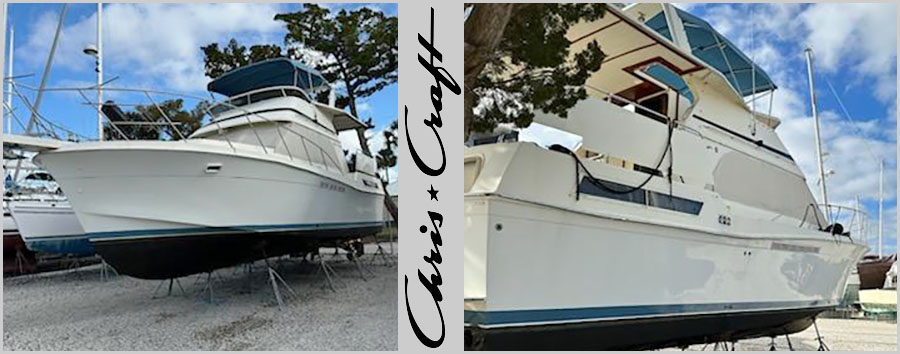
42' Chris Craft 1986 - 426 Catalina
This well cared for Chris-Craft shows well and ran well from Dayton Beach, FL to St Augustine, FL for haul and land storage.
Search Our Inventory
We specialize in the sale of yachts, boats and more…, this week’s featured listings.
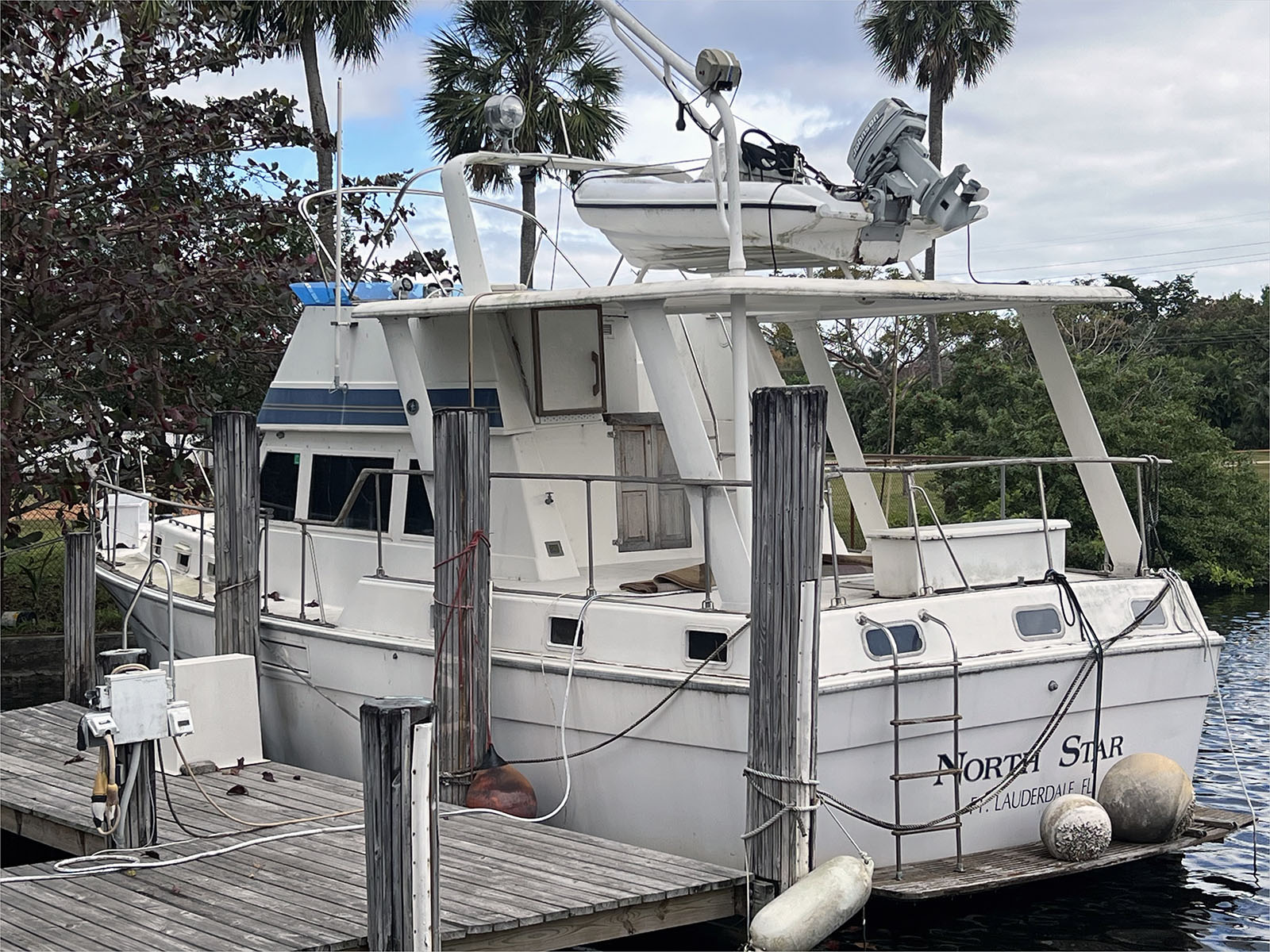
44' Gulfstar 1978 Motor Cruiser
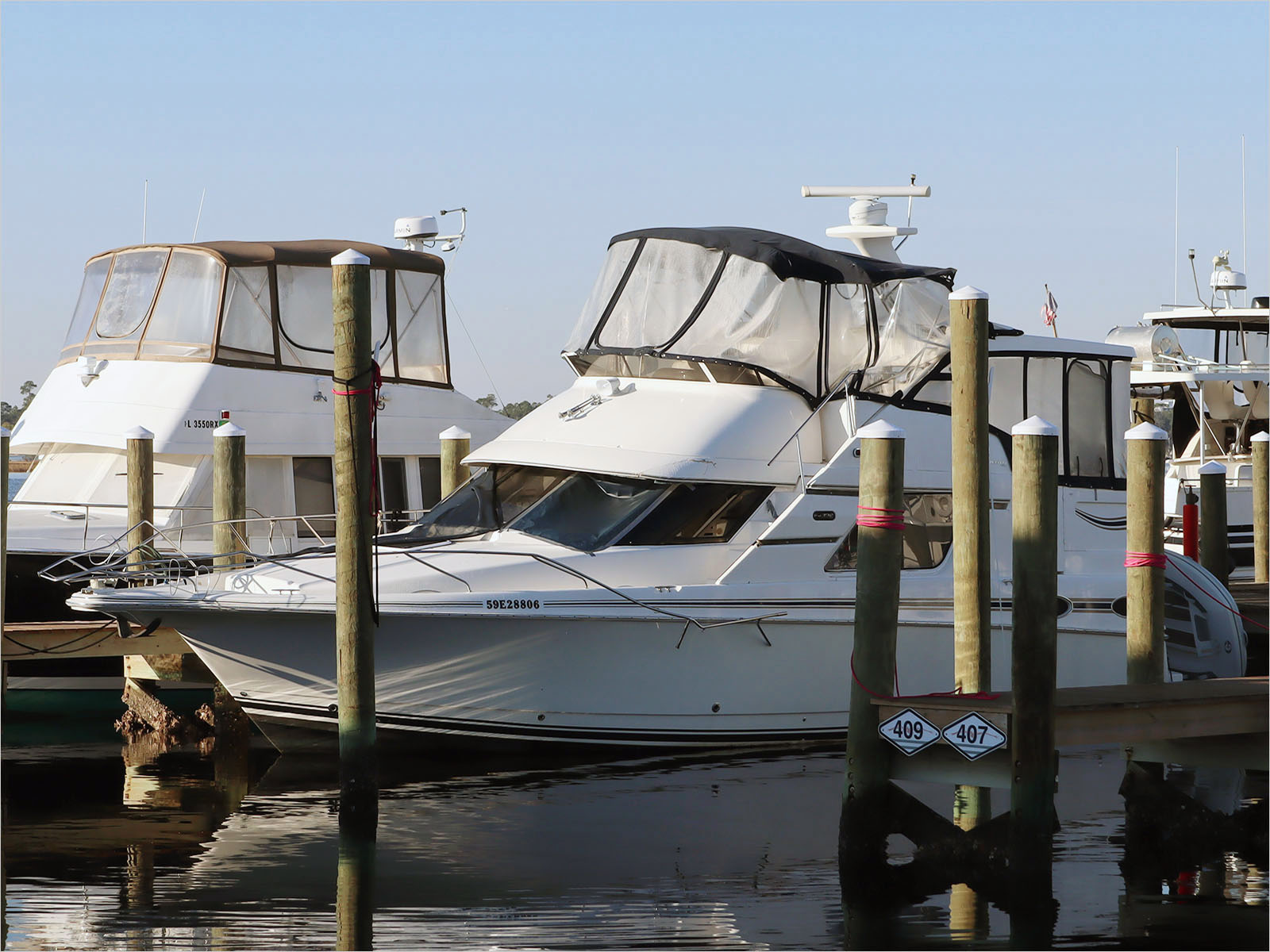
39' Silverton 2000 392
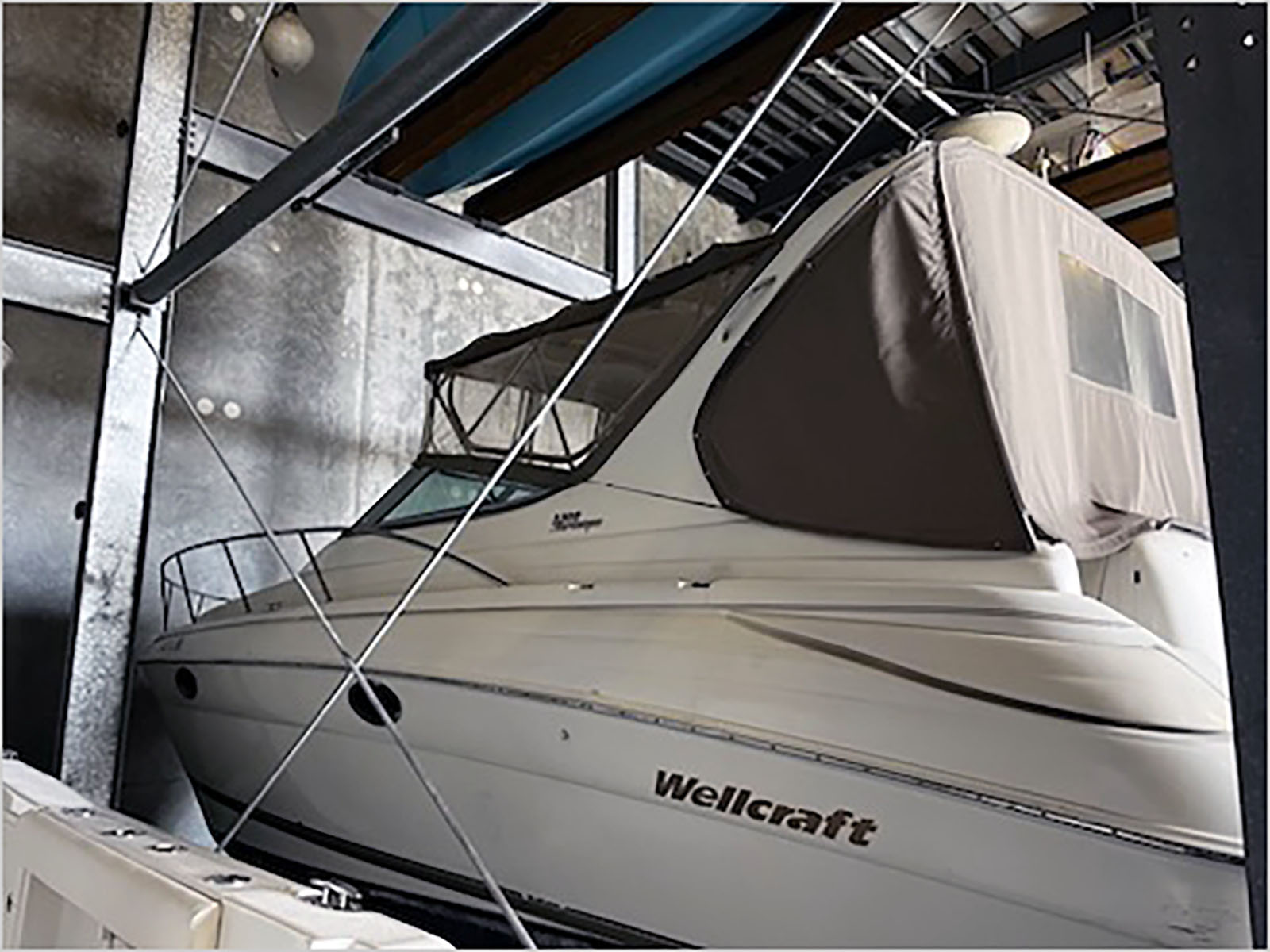
33' Wellcraft 2001 3300 Martinique

Home » Blog » Gear » Watermakers: a guide to marine desalinators and making water on a boat
Watermakers: a guide to marine desalinators and making water on a boat
By Author Fiona McGlynn
Posted on Last updated: March 23, 2022
There’s something magical about a watermaker—at least that’s how I felt after we installed one on our boat. That may sound overblown, but think about it: watermakers transform salt water into fresh water, providing a near-endless supply of potable water for drinking, bathing, and cleaning! THAT my friends is an amazing piece of technology!
(If you don’t share my enthusiasm, try going without a shower for a few days and you’ll begin to see my point).
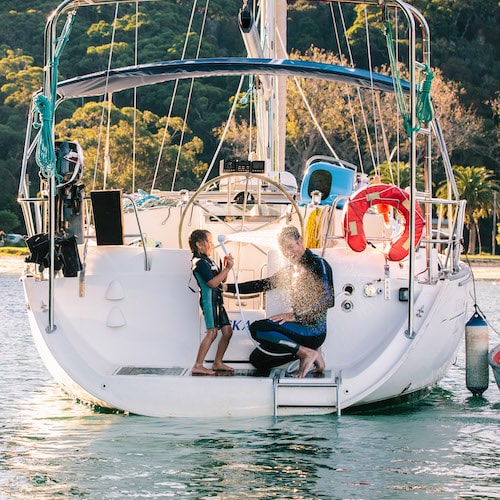
Having experienced living on a boat and cruising, both with and without a marine desalinator, I can attest that it’s a game-changing piece of gear. However, you definitely don’t need one to go cruising. There are plenty of low-tech ways to collect and make water on a boat.
Marine desalinators do offer some major benefits: there’s more water for showers, it’s easier to travel farther afield, you can spend more time in a remote location. However, these benefits have to be weighed against the drawbacks: namely a hefty price tag and ongoing maintenance.
Deciding whether a watermaker is right for you will come down to the type of cruising you’re doing, how much water you need, and your budget. Read on to learn about the pros and cons, costs, and key features of marine watermakers.
Table of contents
- 1 How does a watermaker work?
- 2.1 Benefits
- 2.2 Drawbacks
- 3.1 Powered or handpump
- 3.2 Electric or engine drive
- 3.3 Energy recovery watermaker
- 3.4 Modular, self-contained, and portable watermakers
- 3.5 Automatic flushing systems
- 3.6 Automatic Pressure Regulation and adjustable pump speed
- 3.7 Remote control panels
- 4 Top watermaker brands
How does a watermaker work?
A watermaker on a yacht converts seawater into fresh water through a process known as reverse osmosis (RO). A high-pressure pump pushes seawater through a semi-permeable membrane that filters out salt, organics, and bacteria. The fresh water is pumped into your water tanks while the remaining brine bi-product is discharged over the side of the boat, back into the ocean.
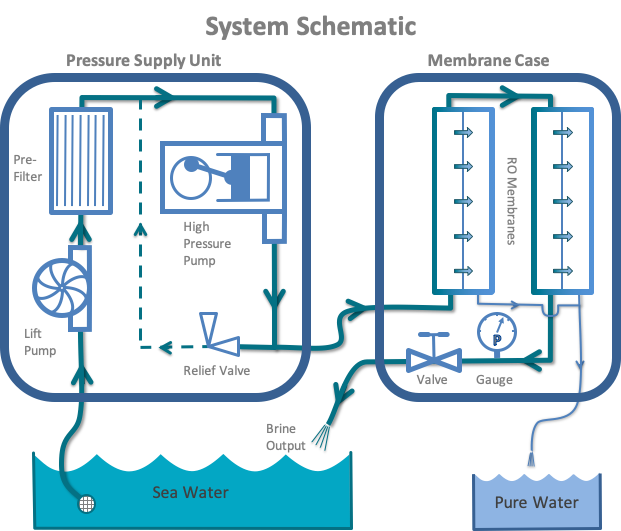
Marine watermakers: the benefits and drawbacks
Less water rationing.
When we started our 13,000 mile trip across the Pacific, we didn’t have a watermaker. We were on a tight budget and decided to prioritize other pieces of equipment like a life raft and wind vane.
As a result, we became experts in conserving water on a boat . We would carefully ration out water for washing dishes, taking showers, and even brushing our teeth!
After getting a watermaker we became far less meiserly because we knew we could always make more water if we needed to. It was a relief to not be constantly thinking about how much water we were using over the course of a day.
That being said, we couldn’t relax completely. We had to keep our tanks topped up, so as not to run the pump dry. We also always carried potable water in reserve, in case our watermaker broke in the middle of a long passage.
More luxuries
Can’t live without a proper shower? A boat water maker can make water-intensive luxuries like freshwater deck washdown, freshwater flushing heads, laundry, daily showers, and even baths, a possibility.
As great as this sounds in theory, we were surprised to find that we didn’t indulge in more showers after we got the watermaker.
We continued to use a hand pump pesticide sprayer to shower on deck despite having a watermaker and shower below. While some of this came down to habit, we also disliked running our engine (and consuming diesel) just to run the watermaker.
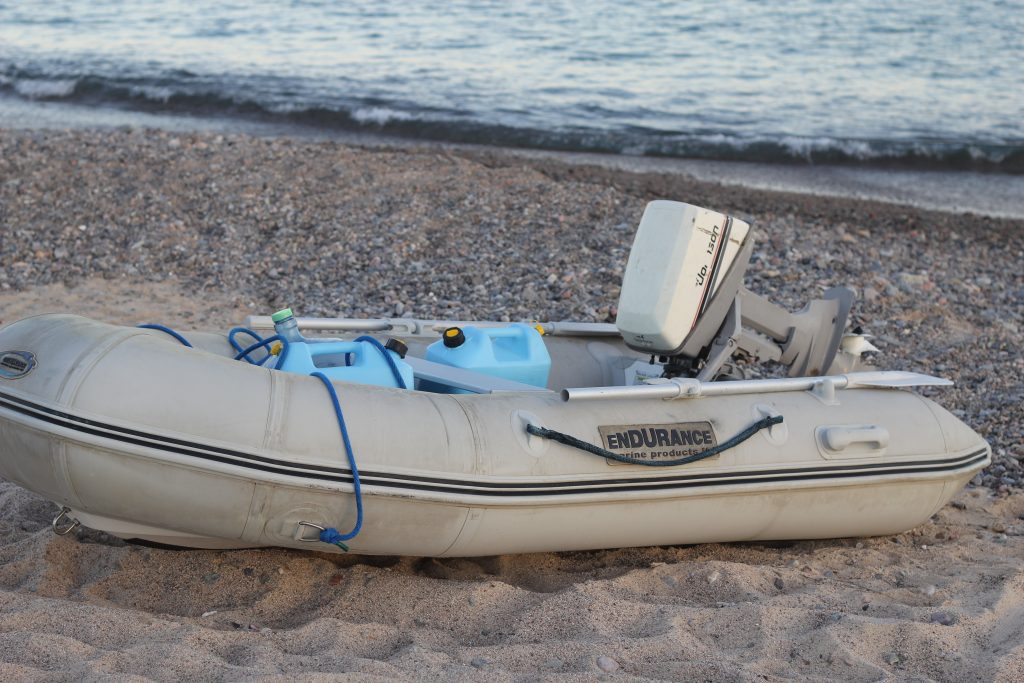
No hauling water
For us, this was by far the greatest benefit of having a watermaker!
While cruising in the US and Canada, we could refill our water tanks at a dock or marina. This was a minor hassle because it involved pulling up the anchor and docking the boat.
In Mexico, it was more challenging to get water. We would fill 5-gallon jugs at the local water purification plant in town and wheel them back to our boat on a collapsible dolly.
It often took a couple of trips with the dolly and dinghy to fill our water tanks. Oh, and we broke our dolly, twice!
We realized that if we wanted to spend more time exploring, and less time hauling water, we would have to invest in a watermaker. When we reached La Paz, Mexico we bought a refurbished watermaker, and we were so glad we did!
Our sailboat water maker gave us the gift of time, especially in places like Mexico and the South Pacific, where there were limited opportunities to fill water tanks up at the docks. It also saved us paying docking and water fees.
We estimate that our boat water maker saved us anywhere from four to six hours every week, time that we could spend exploring the wonderful places we were visiting.
A clean, safe water source
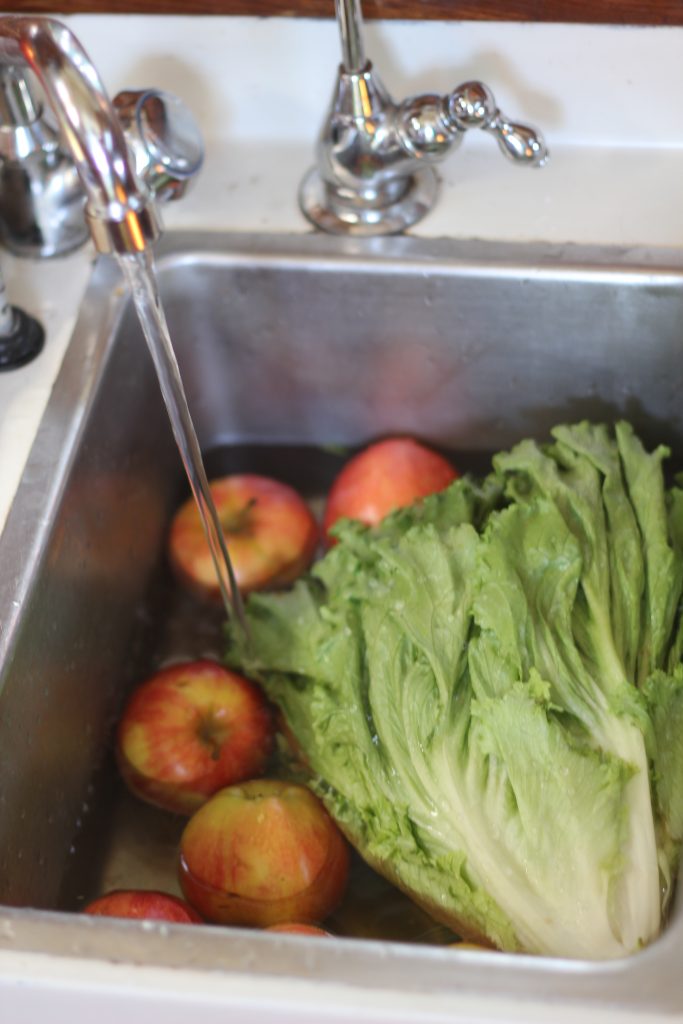
In places where the drinking water may be suspect, a boat water maker can be a reliable source of safe drinking water (assuming it’s in good working condition!).
More time in remote locations
A watermaker is a great tool if you’re drawn to remote locations where you might be the only boat in the anchorage.
It wasn’t until we reached Los Frailes, a secluded village on the Baja, that we really began to think about buying a watermaker.
There we were in an idyllic anchorage, surrounded by spectacular hiking and fishing. There was only one problem—every two days we had to walk 10 miles into town with our water jugs and hope that some kind samaritan would give us a lift back to our boat.
Before having a watermaker, we’d often leave a place we loved just because we needed to fill up our tanks. With a watermaker, we were more self-sufficient and could stay an extra few days, or as long as we wanted!
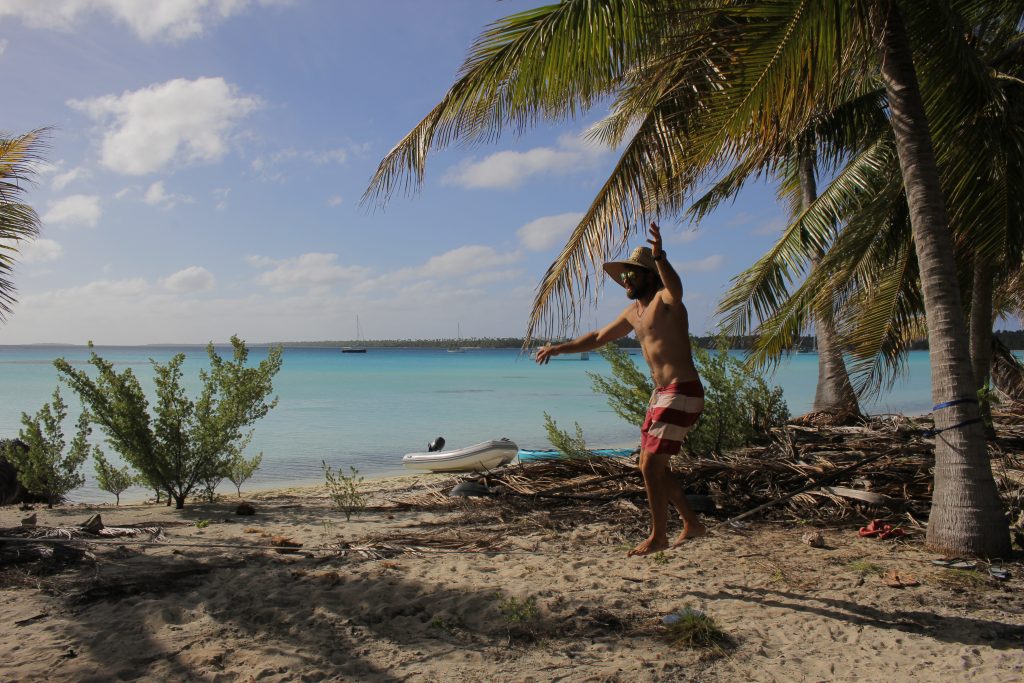
The number one drawback is the cost. We were able to find a refurbished water desalinator for $3,000, which was a great deal but also a considerable slice out of our cruising kitty.
How much does a watermaker cost?
Powered desalination systems for your average recreational cruising boat range from around 3,500 USD to 11,000 USD, with the more expensive options offering higher production (gallons of fresh water per hour).
Ongoing maintenance
Watermakers are yet another piece of boat equipment that needs to be maintained.
The majority of watermaker problems are caused by not using it enough or not using it properly.
If a watermaker is not used for a few weeks, the planktonic organisms in the seawater will die, rot, and clog the membrane and filters. This can eventually damage the reverse osmosis membrane in the watermaker.
For this reason, boat water makers should be used frequently and regularly flushed with fresh water.
Watermaker flushing
Check your manufacturer’s instructions on how to flush.
Rainman recommends flushing the seawater out of the system with fresh water if you are not using the system for more than a day or two. After another week, you need to freshwater flush the system again or pickle it for long-term storage.
Of course, it’s easy to forget, so we made it a rule to freshwater flush our watermaker after every use.
This is one good reason to choose a watermaker with an output that will meet your water consumption needs but not exceed them. If you’re using it every second day, you won’t have to try and remember whether you’ve flushed it or not.
Flushing a watermaker is relatively simple but it does involve a bit of work. We used a system with buckets of fresh water to flush our system and it generally took about 5 minutes.
You can also buy systems that automatically flush your watermaker at pre-determined times—even when you’re away from the boat (more on autoflush systems below).
Whatever you do, don’t use chlorinated water to flush as it will destroy reverse osmosis membranes. It’s possible to buy a carbon filter to remove chlorine from water sources at the dock.
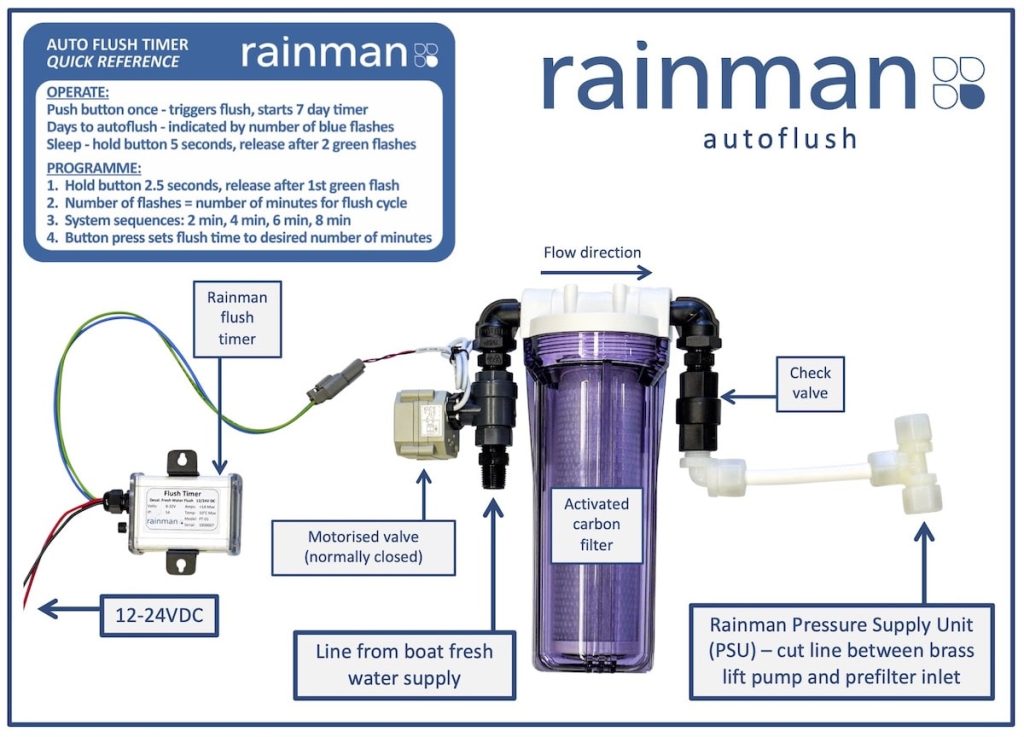
Pickling a watermaker
If you don’t plan on using your watermaker for a while it needs to be “pickled” with a special biocide to prevent growth and buildup which could render your reverse osmosis membrane totally useless.
A watermaker should also be pickled every so often to chemically cleanse the membrane.
In addition to flushing and pickling, you will also need to clean out and replace the raw water pre-filters.
Operating costs
When properly cared for, a membrane should last five to ten years. If you don’t properly flush or pickle your watermaker, it can be a lot sooner and membranes aren’t cheap, generally costing in the range of 200-700 USD.
You’ll also need to purchase pre-filters and pickling solution, which are generally quite affordable. It’s also a good idea to carry spare parts

Power consumption
Watermakers can be real power hogs. When Practical Sailor tested a dozen DC watermakers they found they could draw anywhere from 12 to 48 watts per gallon, a huge range in efficiency!
According to Practical Sailor, “for maximum efficiency none of the systems drawing 15 amps or more should be operated without running the engine at the same time.”
We had to run our engine for hours to fill our tanks, which was annoying (and loud) when we were hanging out at anchor and also used up another finite resource—diesel fuel.
In our view, this was the single largest drawback to having a watermaker aboard.
Keep in mind that your power supply will determine what type of watermaker you buy. You may need to upgrade your electrical panels, get a generator or high-powered alternator, add solar panels, or increase battery capacity to supply the demand.
You can’t make water everywhere
While watermakers offer great flexibility and freedom, you can’t just make water in any old spot. If you make water in a polluted marina or anchorage, you’ll risk clogging up your filter. Most cruisers will head out to open water to ensure the saltwater they’re using is as clean as possible.
Key features to look for
Powered or handpump, handpump watermakers.
Handpump watermakers tend to be small and portable, the perfect thing to keep in your ditch bag in the event of an emergency. They’re less expensive than powered watermakers and produce far less water, usually around one gallon per hour.
Though I do know cruisers who have used a handpump watermaker for everyday use, they typically tend to be kept aboard for survival situations.
Powered watermakers
Powered watermakers run off your electrical supply or engine and can produce tens of gallons of water per hour. They tend to be a lot more expensive, but they’re productive enough to replenish your tanks.
Electric or engine drive
Powered watermakers can be electrically driven, by AC or DC, or run off the boat engine.
AC watermakers
AC models can produce in the range of 20-60 gph and are ideal for cruisers with an AC generator or alternator on board. They can also be used on boats with ample solar or wind sources and an inverter.
DC watermakers
DC watermaker systems typically produce in the range of 10-30 gph and are ideal for boats with solar power or 12V battery power.
Engine-driven watermakers
On an engine-driven watermaker, the high-pressure pump is belt-driven. These can produce a considerable amount of water, even on small engines. For instance, engine-driven units produce between 20-60gph, twice what a DC unit can produce.
Energy recovery watermaker
DC watermakers have become more efficient in recent years thanks to energy recovery systems (ERS). When the water leaves the watermaker it is still under pressure. ERS uses a set of valves to make use of this excess pressure to help drive the pump, which can reduce energy consumption by as much as 80 percent.
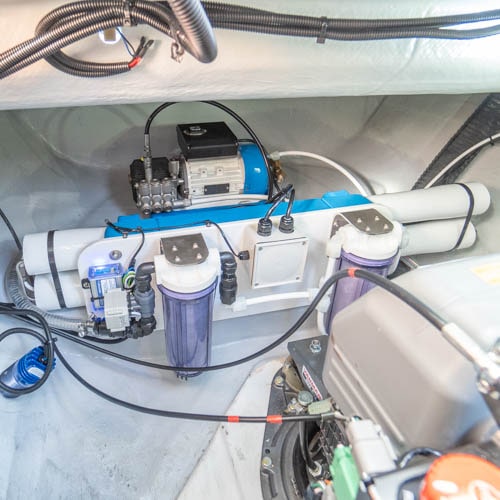
Modular, self-contained, and portable watermakers
Watermakers can be bought as modular, self-contained, and portable units. Choosing the right one may depend on your boat size and layout and whether you’re comfortable installing the watermaker yourself.
Modular units
Modular units come as several separate components that you can mount and connect yourself. This obviously offers a lot more flexibility and is particularly useful on smaller vessels where you may not have a lot of space. The downside is that these systems will take longer to install.
Self-contained units
Self-contained units arrive pre-assembled. While easier to install, they’re often bulkier and best suited to a bigger cruising sailboat with a large engine room.
Portable watermakers
Portable watermaker systems, like the Rainman watermakers, are entirely self-contained. Their compact design makes them easy to move and stow and you can completely avoid a permanent installation.
Simply put the intake and brine discharge hoses overboard, the freshwater hose in your water tank and you’ll be making water in no time.
If you race, have multiple boats, or plan on selling your boat, a portable watermaker is a great option because it can be easily moved from boat to boat.
If we were to buy another watermaker, we would probably opt for a portable one.
Automatic flushing systems
Automatic flushing systems use your boat’s freshwater supply to flush the watermaker for several minutes every few days. These systems require additional components (e.g., a timer, carbon filters, and a motorized valve) and installation but they take a lot of the maintenance out of having a watermaker onboard.
Automatic Pressure Regulation and adjustable pump speed
Your watermaker’s efficiency will be affected by the temperature and salinity of the water you’re cruising in. Cold and highly saline waters (e.g., in the high latitudes) will be more work for your watermaker, so it will take longer to purify.
Some units feature Automatic Pressure Regulation (APR) and adjustable pump speed which can help compensate for fluctuations in water temperature and salinity.
Remote control panels
Some watermakers have the option of a control panel which allows for easier access and remote control. Control panels tend to have a fairly simple interface with just a few gauges but may include a salinity sensor—so you can keep tabs on water quality—and auto-flush integration—so you can flush your watermaker with the flip of a switch.

Top watermaker brands
If you’re considering buying a watermaker for a boat, here are some of the top brands to consider.
- Cruise RO Watermaker
- Echotec watermakers
- Horizon Reverse Osmosis (HRO)
- Sea Recovery watermakers
- Schenker watermakers
- Spectra watermakers
Fiona McGlynn is an award-winning boating writer who created Waterborne as a place to learn about living aboard and traveling the world by sailboat. She has written for boating magazines including BoatUS, SAIL, Cruising World, and Good Old Boat. She’s also a contributing editor at Good Old Boat and BoatUS Magazine. In 2017, Fiona and her husband completed a 3-year, 13,000-mile voyage from Vancouver to Mexico to Australia on their 35-foot sailboat.
Terms and Conditions - Privacy Policy
- International

March 26, 2024 - Baltimore Key Bridge collapses after ship collision
By Helen Regan , Kathleen Magramo , Antoinette Radford, Alisha Ebrahimji , Maureen Chowdhury , Rachel Ramirez , Elise Hammond , Aditi Sangal , Tori B. Powell , Piper Hudspeth Blackburn and Kathleen Magramo , CNN
Our live coverage of the Baltimore bridge collapse has moved here .
Crew member on DALI said everyone on board was safe hours after bridge collapse, official says
From CNN’s Amy Simonson
A crew member on the DALI cargo ship sent a message hours after the Francis Scott Key Bridge collapsed Tuesday saying everybody on board was safe, according to Apostleship of the Sea director Andy Middleton.
Middleton, who spent time with the captain of the DALI Monday, told CNN’s Laura Coates he reached out to a crew member after hearing about the incident Tuesday morning.
He said there were 22 members aboard the ship from India who were setting sail earlier Tuesday morning and were heading toward Sri Lanka.
“I was able to reach out to a crew member very early this morning around 5:30 (a.m. ET) or 6 (a.m. ET) and get a message to them asking if they were OK,” he said. “That crew member responded within just a few minutes advising that the crew was safe, and everybody that [was] on board was safe.”
Middleton was told by the ship's captain Monday that the vessel was going to take a longer route to avoid risks along the Yemen coast.
“When I was out with the captain yesterday, we were talking while we were driving, and he advised that they were sailing down and around the tip of South Africa in order to avoid the incidents that are going on off the Yemen coast, and it was a safer way to go,” he said.
Middleton said the Apostleship of the Sea is a ministry to seafarers with members that spend time in the port and on the vessels as a friendly face to the seafarers that visit the Port of Baltimore, “taking care of their needs to make sure that they're reminded of their God-given human dignity when they're here in Baltimore.”
Search operation ends in "heartbreaking conclusion," Maryland governor says. Here's the latest
From CNN staff
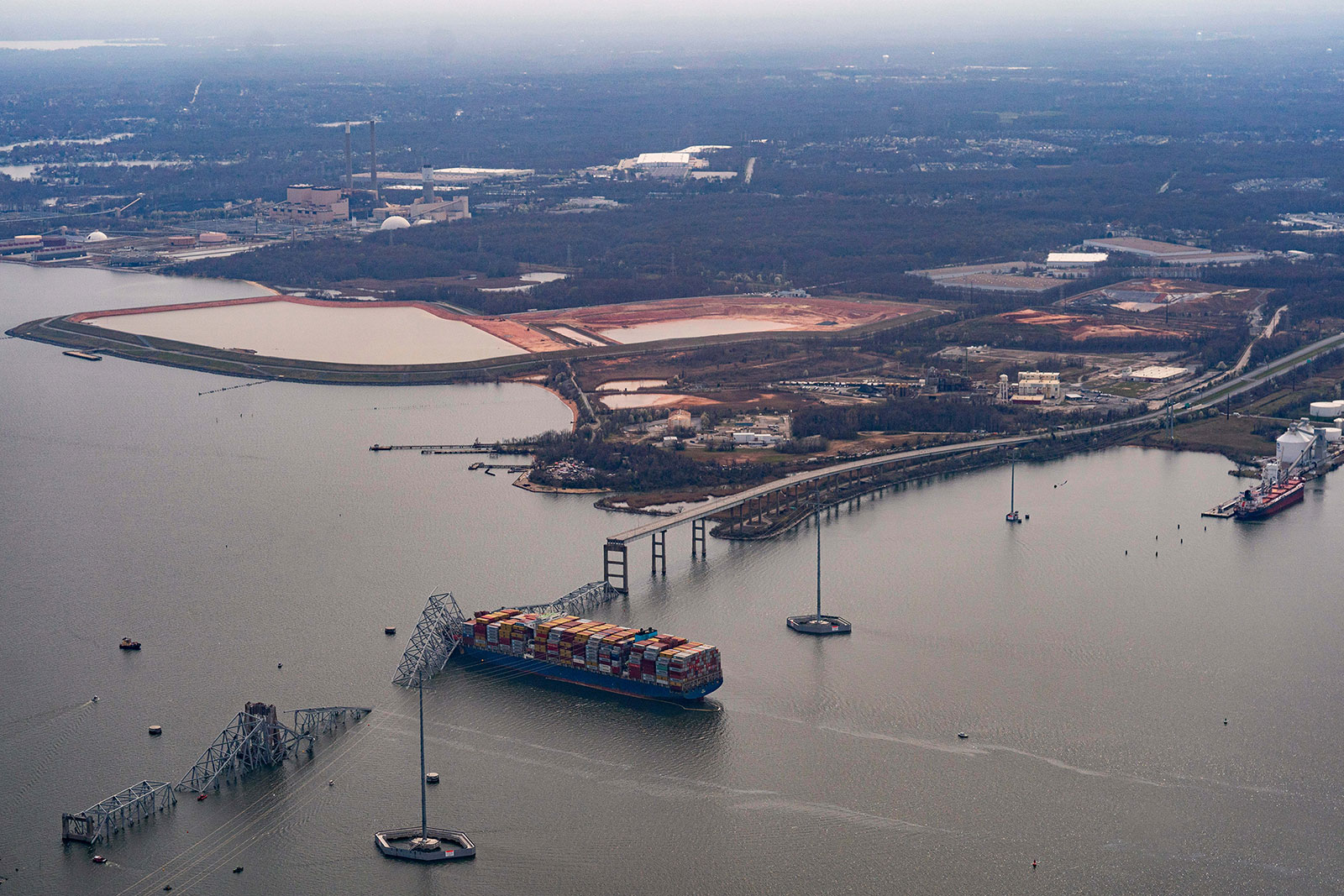
Six people, who were believed to be part of a road construction crew, are presumed dead after Baltimore's Francis Scott Key Bridge collapsed early Tuesday morning. The collapse came after a 984-foot cargo ship hit the bridge's pillar.
Maryland Gov. Wes Moore told reporters Tuesday evening it's a "really heartbreaking conclusion to a challenging day."
Late Tuesday, it was discovered that two of the construction workers who went missing after the bridge collapsed were from Guatemala , the country's Ministry of Foreign Affairs said late Tuesday.
Here's what you should know to get up to speed:
- The victims: Eight people were on the bridge when it fell, according to officials. At least two people were rescued — one was taken to the hospital and was later discharged , fire official and the medical center said.
- The incident: Video shows the moment the entire bridge structure falls into the water, as the ship hits one of the bridge's pillars. CNN analysis shows that the ships lights flickered and it veered off course before it hit the bridge. Maryland Gov. Wes Moore said the crew on the ship were able to issue a "mayday" before colliding into the bridge, which allowed the authorities to stop incoming traffic from going onto the bridge.
- Response efforts: Earlier, dive teams from various state and local agencies were brought in to assist in search-and-rescue operations, according to Maryland State Police Secretary Col. Roland L. Butler Jr.. The mission started with 50 personnel and continued to grow before the Coast Guard announced Tuesday evening that it was suspending its active search-and-rescue operation and transitioning to a "different phase."
- The investigation: Authorities are still working to establish exactly how the crash occurred. The National Transportation Safety Board will look into how the bridge was built and investigate the structure itself. It will "take time to dig through" whether the bridge had ever been flagged for any safety deficiencies , NTSB Chair Jennifer Homendy said.
- Rebuilding the bridge: US Sen. Chris Van Hollen said the path to rebuilding the bridge will be "long and expensive." Senior White House adviser Tom Perez told reporters Tuesday “it’s too early” to tell how long it will take to rebuild the bridge. President Joe Biden said Tuesday he wants the federal government to bear the full cost of rebuilding the collapsed bridge, noting that it will not wait for the company who owns the container ship DALI to shoulder the costs. Funding could come from the Federal Highway Administration as well as the Bipartisan Infrastructure Law, but it may require additional funding from Congress.
2 of the missing construction workers from bridge collapse were from Guatemala, foreign ministry says
From CNN’s Allison Gordon, Flora Charner and Amy Simonson
Two of the construction workers missing from the bridge collapse in Baltimore were from Guatemala, the country's Ministry of Foreign Affairs said in a statement late Tuesday.
Those missing included a 26-year-old originally from San Luis, Petén. The other is a 35-year-old from Camotán, Chiquimula, the statement said.
The ministry said both were part of a work team “repairing the asphalt on the bridge at the time of the accident.”
The statement did not name the two people missing, but it said the country’s consul general in Maryland “went to the area where the families of those affected are located,” where he hopes to be able to meet with the brothers of both missing people.
The consulate also issued a statement Tuesday saying its consul general in Maryland "remains in contact with local authorities," and also confirmed that two of those missing "were of Guatemalan origin.”
Six people, who were believed to be part of a road construction crew, are presumed dead after Baltimore's Francis Scott Key Bridge collapsed early Tuesday morning when a cargo ship hit the bridge's pillar.
State and federal officials have not released information about the identities of any of the six missing workers.
Underwater mapping of bridge collapse area to begin Wednesday, Baltimore fire chief says
From CNN's Jennifer Henderson
Search operations near the Key Bridge collapse have shut down for the night due to dangerous conditions, but the process of underwater mapping with many local, state and federal dive teams will begin Wednesday, Baltimore City Fire Chief James Wallace told CNN’s Anderson Cooper Tuesday night.
Wallace said the portion of the Patapsco River is “tidal influenced, so it goes through tide cycles just like the open waters of the Chesapeake Bay does.”
The water depths in the area under the bridge vary from 40 feet to more than 60 feet, Wallace said. The deeper the divers go, the colder the temperatures they encounter, and the visibility is zero, he added.
Wallace said when crews arrived Tuesday morning, the surface water temperatures of the Patapsco River were about 47 degrees with an air temperature of 44-45 degrees.
Here's what you should know about the historic Francis Scott Key Bridge
The Francis Scott Key Bridge collapsed early Tuesday after a massive container ship lost power and crashed into the iconic Baltimore bridge, sending people and vehicles into the frigid Patapsco River.
Six people, believed to be part of a road construction crew, are presumed dead and the Coast Guard has ended its active search and rescue mission.
Here's what you should know about the historic bridge:
- How old?: The Francis Scott Key Bridge, also referred to as just the Key Bridge, opened to traffic in March 1977 and is the final link in the Baltimore Beltway, according to the Maryland Transportation Authority (MDTA.) It crosses over the 50-foot-deep Patapsco River, where former US attorney Francis Scott Key found inspiration to write the lyrics to the Star Spangled Banner, the MDTA says.
- How long?: The bridge was 1.6 miles long when standing, MDTA reports.
- Traffic volume: More than 30,000 people commuted daily on the bridge, according to Maryland Gov. Wes Moore.
- How much did it cost?: The bridge cost $60.3 million to build, MDTA says. Since its collapse, President Joe Biden said he’s committed to helping rebuild the bridge as soon as possible.
- About the port: Baltimore ranks as the ninth biggest US port for international cargo. It handled a record 52.3 million tons, valued at $80.8 billion, in 2023. According to the Maryland state government, the port supports 15,330 direct jobs and 139,180 jobs in related services.
- About the ship: The bridge collapsed after a container vessel called Dali collided with one of its supports. Dali is operated by Singapore-based Synergy Group but had been chartered to carry cargo by Danish shipping giant Maersk . The ship is about 984 feet long , according to MarineTraffic data. That’s the length of almost three football fields.
Baltimore woman says bridge collapse was "like a piece of family dissolved"
From CNN's Kit Maher
For longtime Baltimore resident, Ceely, who opted not to share her last name, seeing footage of the Francis Scott Key Bridge collapse Tuesday was deeply personal.
“I was very heavy-hearted,” Ceely told CNN. “Very tearful, thinking about the families whose loved ones may be in the water and just remembering when the bridge was constructed, and it was just like a piece of family dissolved.”
Ceely was at a prayer group Tuesday morning when she saw the news. She recalled being afraid when she first crossed the bridge while in Ford Maverick in 1975, but grew to like it because it saved time on the road.
“It was a main artery just like a blood line. It was a main artery to the other side of town. It was awesome. It beat going through the city all the time,” she said.
Elder Rashad A. Singletary , a senior pastor who led Tuesday night’s vigil at Mt. Olive Baptist Church told CNN that many church members watched the bridge's construction.
"It’s a part of the community. A lot of our individuals in our congregation drive that bridge to go to work, and so now it’s really a life changing moment,” he said.
"Heartbreaking conclusion to a challenging day," Maryland governor says as Coast Guard ended search operation
From CNN's Aditi Sangal
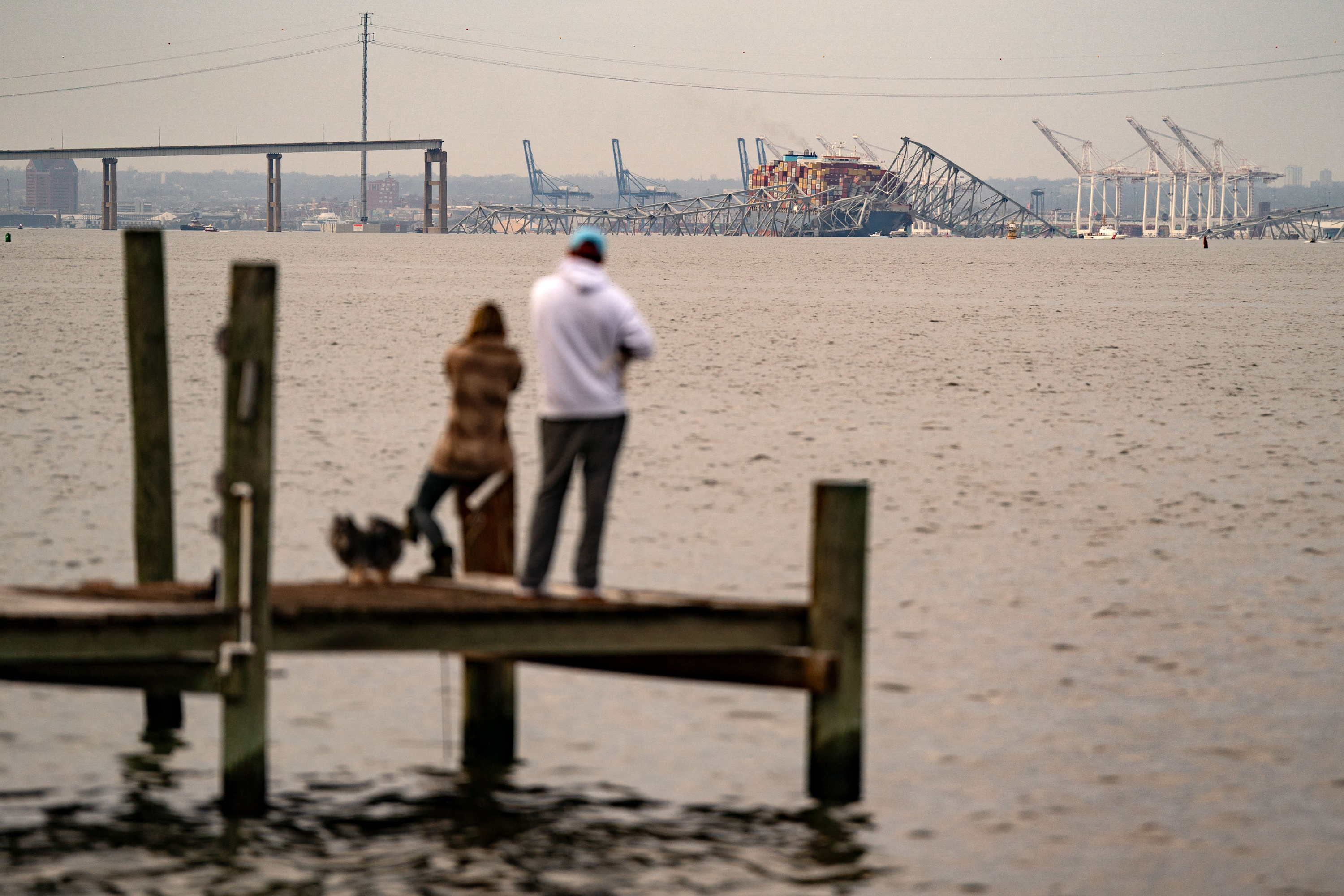
More than 18 hours after the collapse of the Baltimore bridge, Maryland Gov. Wes Moore said it was a heartbreaking conclusion after the Coast Guard ended the search-and-rescue operation for the six people who were on the bridge when it collapsed.
It's a "really heartbreaking conclusion to a challenging day," he said.
"We put every single asset possible — air, land and sea" to find the missing people, he told reporters on Tuesday evening. "While even though we're moving on now to a recovery mission, we're still fully committed to making sure that we're going to use every single asset to now bring a sense of closure to the families," the governor added.
6 people presumed dead after Baltimore bridge collapse, Coast Guard says. Here's what we know
As the sun sets in Baltimore, six people are presumed dead after a major bridge collapsed overnight Tuesday, according to the Coast Guard. The Francis Scott Key Bridge came down around 1:30 a.m. ET after a cargo ship collided with it.
The Coast Guard said it has ended its active search-and-rescue operation for the missing construction workers who were on the bridge when it collapsed.
- What we know: Eight people were on the bridge when it fell, according to officials. At least two people were rescued — one was taken to the hospital and has been discharged . The Coast Guard has been searching for six other people. But, around 7:30 p.m. ET, the Coast Guard said it has transitioned to a “different phase” of operation, now it did “not believe we are going to find any of these individuals alive,” Rear Adm. Shannon Gilreath said.
- About the ship: The bridge collapsed after a container vessel called Dali collided with one of its supports. The vessel is operated by Singapore-based Synergy Group but had been chartered to carry cargo by Danish shipping giant Maersk . The US Embassy in Singapore has been in contact with the country’s Maritime and Port Authority, a State Department spokesperson said.
- The investigation: The National Transportation Safety Board is leading the investigation into the collapse. A team of 24 experts will dig into nautical operations, vessel operations, safety history records, owners, operators, company policy and any safety management systems or programs, said NTSB Chair Jennifer Homendy. A voyage data recorder will be critical to the investigation, she added.
- Vehicles on the bridge: Officials are also working to verify the numbers of how many cars and people were on the bridge, Homendy said. Gov. Wes Moore said the quick work of authorities in closing the bridge had saved lives . Radio traffic captured how authorities stopped traffic and worked to clear the bridge seconds before the impact . Maryland State Police Secretary Col. Roland L. Butler Jr. said there is a “ distinct possibility ” more vehicles were on the bridge, but authorities have not found any evidence to support that.
- Looking ahead: NTSB will look into how the bridge was built and investigate the structure itself, including if it was flagged for any safety deficiencies , Homendy said. The federal government has also directed its resources to help with search and rescue, to reopen the port and rebuild the bridge, Vice President Kamala Harris said . Earlier, President Joe Biden said t he federal government will pay to fix the bridge.
- The economy: Transportation Secretary Pete Buttigieg warned the collapse will have a serious impact on supply chains . Until the channel is reopened, ships will likely already be changing course for other East Coast ports. Ocean carriers are already being diverted from the Port of Baltimore, where the bridge collapsed, to the Port of Virginia to “keep trade moving."
Please enable JavaScript for a better experience.
- International
March 27, 2024 - Baltimore Key Bridge collapse
By Kathleen Magramo , Antoinette Radford, Alisha Ebrahimji , Maureen Chowdhury , Elise Hammond , Tori B. Powell and Aditi Sangal , CNN
Our live coverage of the Baltimore bridge collapse has moved here .
Here's what you should know about the Key Bridge collapse
From CNN staff

Officials recovered the bodies of two construction workers who were on Baltimore's Francis Scott Key Bridge when it collapsed early Tuesday morning after a 984-foot-long cargo ship collided into a pillar.
Maryland Gov. Wes Moore called the collapse Wednesday " a global crisis ."
"The national economy and the world's economy depends on the Port of Baltimore. The port handles more cars and more farm equipment than any other port in the country," Moore said.
Here's what you should know:
- The victims: The six people who are presumed dead were from Mexico Guatemala, El Salvador and Honduras, according to Col. Roland L. Butler Jr, the superintendent of Maryland State Police. Two bodies were recovered and have been identified as Alejandro Hernandez Fuentes from Mexico and Dorlian Ronial Castillo Cabrera from Guatemala. The two workers were filling potholes on the bridge and were later found trapped in a red pickup truck in about 25 feet of water, Butler said. The FBI is handling notifying the victims' families, Butler said.
- Recovery efforts: Authorities are pausing search efforts for the four other workers who are presumed dead, because additional vehicles are encased in concrete and other debris, making it unsafe for divers, Butler said. Once salvage operations clear the debris, divers will search for more remains, he said.
- The investigation: The National Transportation Safety Board is leading the investigation into the fatal incident, according to the agency's chair Jennifer Homendy. During a Wednesday news conference, Homendy said there were 21 crew members and two pilots on board the Dali cargo ship when it crashed into the bridge. She also said a senior NTSB hazmat investigator identified 56 containers of hazardous material, and that some containers are in the water. The agency received six hours of voyage data from the ship and the investigation could take 12 to 24 months to complete, Homendy said. She emphasized that NTSB will not analyze information collected or provide conclusions while on scene of the collapse.
- Looking forward: Department of Transportation Secretary Pete Buttigieg said rebuilding the bridge will not be "quick or easy" but that it will get done. He said there are four main focus points ahead: reopening the port, dealing with supply chain issues until its reopening, rebuilding the bridge and dealing with traffic issues until the bridge is rebuilt. Biden pledged the full support of the federal government in the response and recovery efforts. His administration has already conveyed a sense of urgency to open up federal funding to remove debris and ultimately rebuild the bridge. Maryland has submitted a request to the Biden administration for emergency relief funds "to assist in our work going forward," Moore said Wednesday.
It's almost impossible to place people on the bow of ship due to the unstable structure, fire official says
From CNN's Sarah Engel
Baltimore City Fire Chief James Wallace said Wednesday that the cargo ship's bridge structure and containers at the bow remain unstable.
"It's going to be very difficult, if not impossible, and very dangerous, to place people on the bow of that boat right now," Wallace told CNN's Kaitlan Collins.
"Naturally, we're still very cognizant of the fact that there are hazardous materials on board the vessel itself," Wallace said, alluding to the National Transportation Safety Board saying earlier that 56 containers were carrying hazardous materials.
Wallace said his team is relying heavily on aerial recognizance, including drones. "That's the only way we're able to see in," he said.
He added that the aerial surveillance has "been able to really assure us right now we have no [chemical] reactions on board."
"It's just utter devastation," NTSB chief says of the bridge collapse site
From CNN's Aditi Sangal
Jennifer Homendy, chair of the National Transportation Safety Board, called the site of the Key Bridge collapse "devastating."
"It's pretty devastating, certainly, seeing not just what's going on with the cargo containers, but just looking at what was a bridge span — three bridge spans that is pretty much gone. It's just utter devastation," she said at Wednesday evening's news briefing.
She added that she is thinking of families who lost loved ones and those who are waiting to reunite with their lived ones.
NTSB interviewed the Dali's captain and some other crew members today, agency chief says
The National Transportation Safety Board has interviewed the ship's captain, his mate, the chief engineer and one other engineer today, according to Chair Jennifer Homendy.
The two pilots on board the Dali at the time of collision will be interviewed tomorrow, she added.
Cargo ship's voyage data recorder is basic when compared to an airplane's, NTSB chair says
From CNN's Tori B. Powell
The voyage data recorder on the cargo ship Dali was a "newer model" but is considered basic when compared to that on an airplane, according to National Transportation Safety Board Chair Jennifer Homendy.
"But it is very basic compared to say, a flight data recorder, where we would have 1,000 parameters," she said at a news conference on Wednesday.
The NTSB chief investigator Marcel Muise added:
"It's not a ship-wide system recorder, so most of the sensors that are being recorded are from the bridge. So things like GPS, the audio, rudder feedback, rudder commands are recorded on there. But not engineering, the temperature of each cylinder, power distribution sensors."
There were no tug boats with Dali at the time of the collision. That's normal, NTSB chief says

There were no tugs with Dali when the cargo vessel collided with Baltimore's Key Bridge, which is normal protocol, according to National Transportation Safety Board Chair Jennifer Homendy.
Remember: At 01:26:39 on Tuesday, Dali's pilot made a general very high frequency (VHF) radio call for tugs in the vicinity to assist, the NTSB investigator Marcel Muise had said.
"The tugs help the vessel leave the dock, leave the port and get into the main ship channel. And then they leave. Once it's on its way, it's a straight shot through the channel. So there are no tugs with the vessel at the time. So they were calling for tugs," she said.
NTSB chair says she saw some containers that were carrying hazardous materials in the water
National Transportation Safety Board Chair Jennifer Homendy said she did see some of the 56 containers that were carrying hazardous materials in the water.
When asked how many
When asked how many containers of hazardous materials were in the water, Homendy said:
"I did see some containers in the water, and some breached significantly on the vessel itself," she said. "I don't have an exact number, but it's something that we can provide in an update."
Homendy said that a preliminary report should be out in two to four weeks.
This post has been updated with more quotes from Homendy.
Bridge did not have any redundancy, unlike the preferred method for building bridges today, NTSB chair says
Baltimore's Key Bridge did not have any redundancy, which is included in the preferred method of building bridges in the present day, according to National Transportation Safety Board Chair Jennifer Homendy.
"The bridge is a fracture critical," she explained. "What that means is if a member fails that would likely cause a portion of, or the entire bridge, to collapse, there's no redundancy. The preferred method for building bridges today is that there is redundancy built in, whether that's transmitting loads to another member or some sort of structural redundancy. This bridge did not have redundancy," Homendy said.
There are 17,468 fracture critical bridges in the United States out of 615,000 bridges total, she said, citing the Federal Highway Administration.
Please enable JavaScript for a better experience.
We've detected unusual activity from your computer network
To continue, please click the box below to let us know you're not a robot.
Why did this happen?
Please make sure your browser supports JavaScript and cookies and that you are not blocking them from loading. For more information you can review our Terms of Service and Cookie Policy .
For inquiries related to this message please contact our support team and provide the reference ID below.
- Election 2024
- Entertainment
- Newsletters
- Photography
- Personal Finance
- AP Investigations
- AP Buyline Personal Finance
- Press Releases
- Israel-Hamas War
- Russia-Ukraine War
- Global elections
- Asia Pacific
- Latin America
- Middle East
- Election Results
- Delegate Tracker
- AP & Elections
- March Madness
- AP Top 25 Poll
- Movie reviews
- Book reviews
- Personal finance
- Financial Markets
- Business Highlights
- Financial wellness
- Artificial Intelligence
- Social Media
What to know about the cargo ship Dali, a mid-sized ocean monster that took down a Baltimore bridge
Crews were set to begin removing the wreckage of a collapsed highway bridge in Baltimore on Friday. Maryland Gov. Wes Moore said a large crane, which can lift up to 1,000 tons, would be one of at least two used to clear the channel of the twisted metal and concrete remains of the Francis Scott Key Bridge, and the cargo ship that collided with it this week.
The container ship Dali, owned by Grace Ocean PTE, rests against wreckage of the Francis Scott Key Bridge in the Patapsco River on Wednesday, March 27, 2024, as seen from Pasadena, Md. Investigators began collecting evidence Wednesday from the cargo ship that plowed into Baltimore’s Francis Scott Key Bridge and caused its collapse, while in the waters below divers searched through twisted metal for several construction workers who plunged into the harbor and were feared dead. (AP Photo/Alex Brandon)
- Copy Link copied
In this image taken from video released by the National Transportation and Safety Board, the cargo ship Dali is stuck under part of the structure of the Francis Scott Key Bridge after the ship hit the bridge, Tuesday, March 26, 2024, in Baltimore. (NTSB via AP)
Here’s what to know about the cargo ship Dali that crashed into Baltimore’s Francis Scott Key Bridge, causing it to collapse and leaving six bridge construction workers presumed dead.
MONSTERS OF THE OCEAN
If stood upright, the Dali would reach almost to the top of the Eiffel Tower in Paris or about two-thirds of the way up the Empire State Building in New York.
It can carry the equivalent of almost 10,000 standard-sized metal shipping containers, and at the time of the accident was carrying nearly 4,700 containers. But while those figures are impressive, the Dali pales in comparison to the world’s largest container ships, which can carry more than 24,000 containers. There are environmental and economic advantages to operating giant container ships , but their sheer size and weight make them difficult to maneuver and stop — especially when something goes wrong.
Dali length: 984 feet (300 meters). Weight: 95,000 tons when empty.
Capacity: 10,000 20-foot (6-meter) containers.
MAYDAY CALL SAVES LIVES
The ship shares a name with one of history’s most celebrated artists, Spanish surrealist painter Salvador Dali.
Built by South Korea’s Hyundai Heavy Industries, one of the world’s largest shipbuilders, the Dali was launched in late 2014. It’s owned by Grace Ocean Private Ltd, flies a Singapore flag and is powered by diesel engines.
Danish shipping giant Maersk had chartered the Dali for a planned trip from Baltimore to Sri Lanka, but the ship didn’t get far, with the crew sending a mayday call early Tuesday saying they had lost power and had no control of the steering system. Minutes later, the ship rammed one of the bridge’s columns, causing the entire structure to collapse within seconds.
The ship was moving at about 8 knots, or 9 mph (15 kph). The mayday gave just enough time for authorities to stop bridge traffic and likely prevent more deaths , but not enough time to clear the construction crew that was filling potholes on the bridge. Divers on Wednesday recovered the bodies of two of the workers.
All of the nearly two dozen crew members from the Dali were accounted for after the accident, with one taken to a hospital with minor injuries.
PASSED PREVIOUS INSPECTIONS
The Dali passed a June 2023 inspection in Chile. A faulty pressure gauge for the fuel heaters was identified but fixed before the vessel left the port, according to authorities. The Dali was then inspected in September by the U.S. Coast Guard in New York, and no problems were found. Before it left Baltimore, the ship underwent routine engine maintenance, according to the Coast Guard.
The container ship Dali, owned by Grace Ocean PTE, rests against wreckage of the Francis Scott Key Bridge in the Patapsco River on Wednesday, March 27, 2024, as seen from Pasadena, Md. (AP Photo/Alex Brandon)
Federal and state officials say the crash appears to be an accident.
The Coast Guard has downloaded the voyage data recorder and sent it to the National Transportation Safety Board, which is building a timeline of what led to the crash, and a preliminary report is expected in the coming weeks. Singapore also plans to carry out its own investigation, which it says will be to identify lessons for the future rather than determine liability.
WHAT’S NEXT
In addition to trying to clear the channel floor of the bridge debris, officials will need to assess the damage to the Dali and make sure it doesn’t leak fuel or sink. Investigators found damage to at least 13 containers on the ship.
The Dali will then likely be towed back to the port and the cargo offloaded.
Transportation Secretary Pete Buttigieg says it’s too early to say how long it will take to reopen the Port of Baltimore or replace the destroyed bridge. He noted it initially took five years to build the bridge .

Pollutants and Heavy Metals Taint Moscow’s Water Supply
Studies show that both surface water and groundwater in Moscow are polluted.
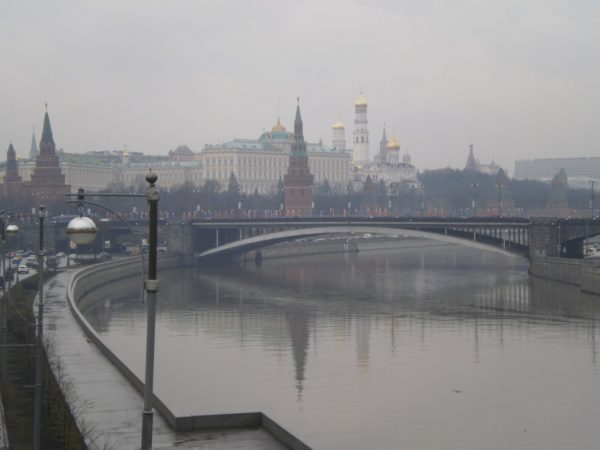
Moskva River. Photo courtesy of Wikimedia Commons .
Russia is rich in water, boasting 2 million lakes, 210,000 rivers, and a quarter of the earth’s freshwater reserves. Despite the country’s bountiful resources, access to clean water is an issue in many towns and cities. Rampant Soviet-era pollution dirtied Russia’s major waterways, and unchecked dumping of chemicals and wastewater continues today.
Water contamination is a concern in Moscow, the country’s capital and largest city. Fifty-six percent of water supply sources in Moscow, home to 12 million, do not meet safety standards. Studies have shown both surface and groundwater pollution in the city.
In 2013, Greenpeace Russia analyzed contamination in Moscow’s key river , the Moskva. The organization collected samples from 10 discharge sites along 50 kilometers of riverbank. Every sample showed high levels of pollutants, including sulfur, oil, heavy metals, and aluminum.
“There are toxic substances that exceed Russia’s safety standards by many times,” Dmitry Artamonov, head of the Toxics campaign of Greenpeace Russia, told The BRICS Post . In one sample, mercury exceeded safety levels by 20 times; in another sample, manganese surpassed safety levels by 120 times.
Currently, most of Moscow’s drinking water comes from upstream locations which are somewhat cleaner. Researchers warn that the contamination still poses health risks, however. The Moskva flows into the Volga River, which supplies water for agriculture. In many cases, the city’s polluted water is used to produce its food.
The pollution may also pose an increasing risk as the population of Moscow grows. Urbanization will overtake a larger portion of the Moskva River, and water demand will rise. Drawing more water from underground reserves, which are also contaminated, may not be an option.
A 2017 study assessed soil and groundwater contamination in Moscow and found significant concentrations of copper, lead, manganese, and zinc. An array of other heavy metals were also detected, both in the soil and the aquifer. The study noted that the amounts of ammonium, iron, manganese, and cadmium in the groundwater exceeded Russian safety standards. Much of the contamination is believed to be from the textile and leather industry, which dumped wastewater near the testing site in the early 20th century.
A Toxic Legacy
According to official regulatory data, 35 to 60 percent of drinking water reserves in Russia fail to meet safety standards. For surface water and spring water. 40 and 17 percent is impotable, respectively. In total, 11 million Russians do not have access to safe drinking water.
The widespread water pollution is largely due to Soviet-era dumping. Enormous amounts of chemicals and sewage were deposited into Russia’s rivers, including radioactive wastewater in some places. The impact on Russia’s water resources, in Moscow and elsewhere, is immense. In a 2009 survey, Russians named water pollution as the country’s most serious environmental issue .
Troublingly, large-scale industrial dumping continues today. A handful of Russian companies are taking steps to improve the quality of their wastewater, but the incentive is low.
“The Russian government doesn’t do anything to encourage or force manufacturers to curb their toxic pollution,” says Artamonov. “It is only when ecological needs coincide with economic imperatives that the enterprises do anything.”
The government has taken some action, approving the Clean Water Federal Target Programme in 2010 . The aim of the program is to provide clean water to all communities in Russia by replacing infrastructure and improving water quality. According to experts, life expectancy in Russia could rise by 5-7 years if the plan is successfully implemented.
In the past, Russia has also looked for ways to tap its abundant eastern water resources. The majority of the country’s freshwater lies in Siberia, yet most of Russia’s population lives in the west. Although transfer schemes have been considered, the vast distance between the Siberian and European parts of Russia makes it nearly impossible to harness the country’s freshwater. As a result, the future of drinking water in Moscow and other Russian cities remains unclear.
Resources And Further Reading
In context reporting from Circle of Blue: WaterViews | Russia
Addressing Problems with Water Quality in Russia (The Borgen Project) Assessment of soil and Groundwater Contamination by Heavy Metals and Metalloids in Russian and Indian Megacities (Science Direct) AQUASTAT: Russian Federation (FAO) Greenpeace: Moscow River overpolluted (The BRICS Post) Greenpeace examined the Moskva River (Greenpeace) Greenpeace launched Water Patrol on the Moskva River (Greenpeace) Moscow River Passing on Its Pollutants (The Moscow Times) Russia’s Troubled Waters Flow With The Mighty Volga (NPR) Russian Water Industry Remains at Crossroads (Water & Wastewater International)

Kayla Ritter is a recent graduate of Michigan State University, where she studied International Relations and Teaching English to Speakers of Other Languages. She is currently based in Manton, Michigan. Kayla enjoys running, writing, and traveling. Contact Kayla Ritter
You might also like
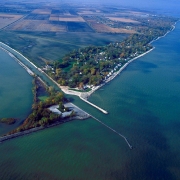
Trackbacks & Pingbacks
[…] action defeated the true purpose of the invasion. According to a 2013 study by Greenpeace, over 11 million Russians are without clean drinking water. Putin is desperate for a freshwater supply. 56% of Moscow’s […]
[…] water safety standards. A study in 2013 found high levels of sulfur, oil, aluminum and other hard metals in Moscow’s main river, the […]
[…] to place. St. Petersburg’s water is officially not drinkable, and Moscow’s water is reportedly polluted with metals and other substances. I drank the tap water without filtering for a time because #rebel… and often had stomach cramps. […]
[…] and other contaminants left from the Soviets. Russia’s government estimates that an incredible 35–60 percent of the country’s drinking water is unsafe for consumption. So much for green […]
Leave a Reply
Leave a reply cancel reply.
© 2023 Circle of Blue – all rights reserved Terms of Service | Privacy Policy
This site uses cookies. By continuing to browse the site, you are agreeing to our use of cookies.
Cookie and Privacy Settings
We may request cookies to be set on your device. We use cookies to let us know when you visit our websites, how you interact with us, to enrich your user experience, and to customize your relationship with our website.
Click on the different category headings to find out more. You can also change some of your preferences. Note that blocking some types of cookies may impact your experience on our websites and the services we are able to offer.
These cookies are strictly necessary to provide you with services available through our website and to use some of its features.
Because these cookies are strictly necessary to deliver the website, refusing them will have impact how our site functions. You always can block or delete cookies by changing your browser settings and force blocking all cookies on this website. But this will always prompt you to accept/refuse cookies when revisiting our site.
We fully respect if you want to refuse cookies but to avoid asking you again and again kindly allow us to store a cookie for that. You are free to opt out any time or opt in for other cookies to get a better experience. If you refuse cookies we will remove all set cookies in our domain.
We provide you with a list of stored cookies on your computer in our domain so you can check what we stored. Due to security reasons we are not able to show or modify cookies from other domains. You can check these in your browser security settings.
We also use different external services like Google Webfonts, Google Maps, and external Video providers. Since these providers may collect personal data like your IP address we allow you to block them here. Please be aware that this might heavily reduce the functionality and appearance of our site. Changes will take effect once you reload the page.
Google Webfont Settings:
Google Map Settings:
Google reCaptcha Settings:
Vimeo and Youtube video embeds:
Share on Mastodon
Philippines flags ‘harassment’ by Chinese vessels ahead of Japan, US drills
Recent clashes between the Philippines and China in the South China Sea have raised concerns of a maritime escalation.
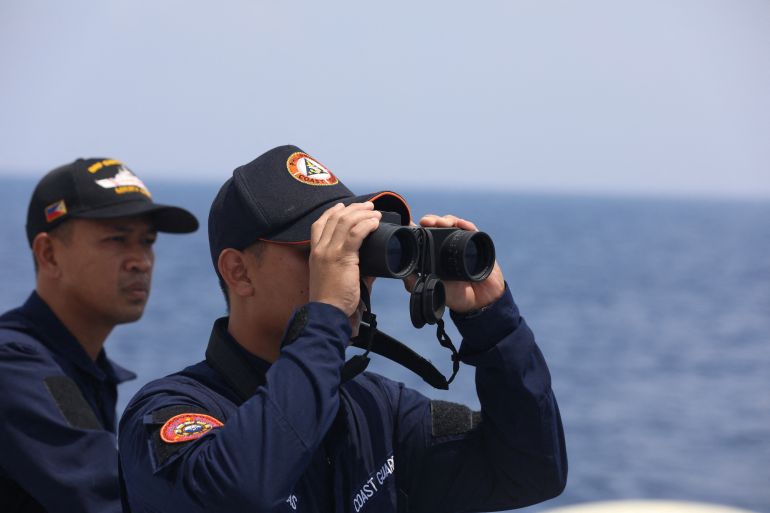
The Philippines has said that two Chinese coastguard ships “harassed” Filipino fishing vessels within its exclusive economic zone (EEZ) in the disputed South China Sea, ahead of joint military drills with its allies.
The coastguard vessels “went as far as pretending to man their water cannon and threatening the Filipino fishermen” in the Iroquois reef on April 4, Jay Tarriela, spokesperson of the Philippine Coast Guard posted on X on Saturday.
Keep reading
Philippines summons beijing envoy over south china sea water cannon attack, philippines accuses china of new water cannon attacks in south china sea, philippines says ship damaged in south china sea incident with chinese boat.
“This aggressive action stems from China’s greed and unfounded claim that these waters belong to them based on their imaginary dashed line,” Tarriela wrote in a statement.
There was no immediate comment from China, which claims sovereignty over almost the entire South China Sea.
“It is important to note that Rozul Reef falls within the Philippines’ EEZ since it is located at approximately 128 nautical miles away from Palawan,” Tarriela added, referring to the reef by its Filipino name. The Philippines also refers to the area of the South China Sea within its EEZ as the West Philippine Sea.
The Philippines and China have reported several maritime run-ins in recent months, which included the use of water cannon. The two countries have long faced off near the disputed reefs in the vast and resource-rich sea lane.
Since taking power in 2022, Philippines President Ferdinand Marcos Jr has pursued warmer ties with the United States and other Western nations and adopted a tough line against what he sees as Chinese hostility.
He said last month that the Philippines will take countermeasures against China after the latest confrontation injured Filipino soldiers and damaged vessels.
On Sunday, the Philippines will host joint naval and air drills with the US, Japan and Australia in the disputed area, as it seeks to deepen ties with its allies to counter China’s growing assertiveness in the region.
In a joint statement on Saturday, the participating defence chiefs of the four countries said the drill would demonstrate their “collective commitment to strengthen regional and international cooperation in support of a free and open Indo-Pacific”.
Next week, US President Joe Biden is due to hold the first trilateral summit with Marcos Jr and Japanese Prime Minister Fumio Kishida in Washington, DC.
The drills will include naval and air force units from all four countries, the statement said, but did not provide further details.
Japan’s embassy in Manila said that “anti-submarine warfare training” would be included in the exercises.
China has blamed the Philippines for raising tensions in the contested waterway.
Top US officials have repeatedly declared the United States’ “ironclad” commitment to defending the Philippines against an armed attack in the South China Sea.
“These activities with our allies Australia, Japan, and the Philippines underscore our shared commitment to ensuring that all countries are free to fly, sail and operate wherever international law allows,” US Secretary of Defense Lloyd Austin said.
Russia-Ukraine War Ukrainian Drones Hit 2 Bases Deep in Russia
- Share full article
- Saratov Oblast, Russia Explosion rocks Russian military base. EYEPRESS via Reuters
- Kyiv Residents take shelter in the Metro. Laura Boushnak for The New York Times
- Irpin Winter in Ukraine. David Guttenfelder for The New York Times
- Kherson region Salvaging a refrigerator from the ruins of a home. Finbarr O'Reilly for The New York Times
- Borodyanka A makeshift center for those whose homes have been destroyed. Dimitar Dilkoff/Agence France-Presse — Getty Images
- Kharkiv Police officers look at collected fragments of Russian rockets. Libkos/Associated Press
- Bakhmut Chopping wood in a basement shelter. Tyler Hicks/The New York Times
- Donetsk An office building destroyed in shelling. Alexander Ermochenko/Reuters
- Eastern Ukraine Soldiers on the front line. Yevhen Titov/Agence France-Presse — Getty Images
Follow live news updates on the Russia-Ukraine war .
Ukraine attacks military bases hundreds of miles inside Russia.

KYIV, Ukraine — Ukraine executed its most brazen attack into Russian territory in the nine-month-old war on Monday, targeting two military bases hundreds of miles inside the country, using drones, according to the Russian Defense Ministry and a senior Ukrainian official.
The drones were launched from Ukrainian territory, and at least one of the strikes was made with the help of special forces close to the base who helped guide the drones to the target, said the official, speaking on the condition of anonymity to convey sensitive information.
The strikes signaled a new willingness by Kyiv to take the fight to bases in the heart of Russia, raising the stakes in the war, and demonstrated for the first time Ukraine’s ability to attack at such long distances. Shortly after the attacks on the bases, Russia sent a barrage of missiles streaking toward Ukrainian cities.
The Kremlin said that the weapons launched by Ukraine were Soviet-era jet drones and were aimed at bases in Ryazan and Engels, about 300 miles from the Ukrainian border. It said that its forces had intercepted the drones, and that “the fall and explosion of the wreckage” had “slightly damaged” two planes, killing three servicemen and wounding four others.
The Engels airfield, on the Volga River in southern Russia, is a base for some of Russia’s long-range, nuclear-capable bombers, including the Tupolev-160 and Tupolev-95. Ukrainian officials say it is also a staging ground for Russia’s unrelenting campaign of missile attacks on infrastructure, which have left millions of Ukrainians with intermittent light, heat or water — or none at all — at the onset of winter. Security footage from an apartment complex near the base showed a fireball lighting up the sky.
The other explosion occurred at the Dyagilevo military base in the central city of Ryazan, only about 100 miles from Moscow, according to Russia’s Defense Ministry. It was there that the fatalities and injuries occurred, the Russian state news agency RIA Novosti reported.
Ukraine’s government declined to publicly acknowledge the strikes, in keeping with its practice with other attacks on Russia and Russian-occupied Crimea.
The Engels air base and the Ryazan military installation are between 300 and 450 miles from the Ukrainian border, which is beyond the range of any known missile in Ukraine’s arsenal.
Even before Russia’s Defense Ministry accused Ukraine of sending drones to attack, the blast at the Engels airfield had prompted some of Russia’s influential pro-invasion bloggers to call for more strikes against Ukraine, and to renew criticism of the Russian armed forces. “Sometimes we feel that even if you put a bomb into these people’s pockets — they wouldn’t notice anyway,” Voenniy Osvedomitel, a popular commentator, wrote on the messaging app Telegram.
After the explosions, Mykhailo Podolyak, an adviser to Ukraine’s president, appeared to note the strikes obliquely, as Ukrainian officials have often done after unexplained explosions inside Russia.
“The Earth is round — discovery made by Galileo,” he wrote on Twitter . “If something is launched into other countries’ airspace, sooner or later unknown flying objects will return to departure point.”
Only a few hours after the explosions, Ukrainian officials said that more than a dozen Russian bombers had taken off from the Engels air base.
Ivan Nechepurenko and Helene Cooper contributed reporting.
— Andrew E. Kramer , Michael Schwirtz and Marc Santora
Russia fired a barrage of missiles across Ukraine on Monday.
Russia launched a volley of missiles at Ukraine’s energy grid on Monday, knocking out power in several regions, officials said, the latest in a monthslong campaign of strikes by Moscow targeting civilian infrastructure.
Ukrainian air defense systems fired into the sky in multiple areas of the country but not all missiles were intercepted. Four people were killed by the Russian strikes, President Volodymyr Zelensky said, and officials reported damage to energy infrastructure.
When air-raid warnings were issued for most of the country, Ukrainians followed a grim routine and headed for bomb shelters in Kyiv and other cities. Shortly after the all-clear was given, Mr. Zelensky addressed the nation to praise both the military and utility workers fighting to keep the lights on.
“Air defenses shot down most of the rockets, energy workers have already started to restore electricity,” he said. Ukraine’s Air Force later said that it had shot down more than 60 missiles out of more than 70 fired.
Russia’s Ministry of Defense said in a statement that it had targeted power plants and other sites in Ukraine. Ukraine’s prime minister said energy facilities were hit in the Kyiv, Vinnytsia and Odesa regions, according to the Ukrinform news agency.
The strikes occurred hours after explosions were reported at two military bases deep inside Russia, including one that Ukraine said has been used as a staging ground for aircraft in previous attacks against Ukraine’s energy grid. Russia’s Ministry of Defense later accused Ukraine of using drones to attack the bases.
By midafternoon in Ukraine, multiple reports had surfaced of inbound missiles. A New York Times reporter south of Kyiv saw a cruise missile in flight traveling toward the capital. Another New York Times reporter observed what appeared to be a surface-to-air-missile launched outside of Sloviansk in eastern Ukraine. The extent of damage, and of casualties, was not immediately clear.
The governor of the Kyiv region, the administrative district around the capital, said that air defense systems had fired at incoming missiles. “Stay in shelters and safe places,” the governor, Oleksiy Kuleba, wrote in a statement on Telegram.
Ukraine’s national energy company, Ukrenergo, said that the “mass missile attack” had damaged electrical facilities. In a statement posted on Facebook , it said emergency energy shutdowns would be imposed to help balance the grid.
Blackouts were reported in several regions, from Sumy in the north along the border with Russia to Odesa in the south on the Black Sea coast.
The Russian military typically launches missiles from multiple directions and in successive waves, a tactic intended to overwhelm or avoid Ukraine’s air defenses, Yuriy Ihnat, a spokesman for the Ukrainian Air Force, told a Ukrainian television news show.
Russia began firing missiles at Ukraine’s energy grid in October after its forces lost ground on the battlefield in two Ukrainian counteroffensive operations in the south and northeast.
Ukrainians have responded to the wave of strikes on infrastructure by building emergency heating shelters in towns, dispatching linemen to repair the grid as swiftly as possible and powering restaurants, stores and hospitals with generators . In hard-hit areas, residents stockpile water in bottles in their homes.
And Ukrainians have adapted. In Kryvyi Rih, a central city that is a hub of the iron-mining industry, miners evacuated to the surface on Monday, lest electricity for their elevators be lost, the city’s mayor said. After past strikes, miners had been trapped underground.
Ukraine has greatly increased its capacity to shoot down incoming missiles, aided by air defense systems supplied by the United States and some European countries..
Carlotta Gall and Thomas Gibbons-Neff contributed reporting.
— Andrew E. Kramer and Matthew Mpoke Bigg
Advertisement
When the air raid sirens ring out, residents of Kyiv head underground.

KYIV, Ukraine — In a city where daily routines have been wrecked by unrelenting Russian missile strikes, unpredictable power cuts and unreliable water supplies, residents of Kyiv know that, at any time, they might have to spend a few hours in an air raid shelter.
It had been 13 days since the last large-scale barrage of Russian missiles fired at targets across Ukraine, the longest stretch without blasts in and around the capital since Moscow began its assault on the nation’s energy infrastructure in early October. For days, Ukrainian officials had been warning that another attack was imminent.
So when the air raid alarms sounded across Kyiv early on Monday afternoon, many people were not surprised. The sirens were followed by warnings that missiles were inbound, and soon after the thunder of air defense systems could be heard over the capital.
“To be honest I feel relief this time,” said Olha Kotrus, 34. “For two weeks there were reports that it might happen and then you live in constant tension.”
Ms. Kotrus was sitting on the floor of a Kyiv metro station with her mom, a cat in a cage and her dog. The dog, dressed in a blue outfit to keep it warm in the winter chill, was visibly stressed. Ms. Kotrus was angry and fed up.
She joined a crowd of hundreds people deep underground at the metro station Golden Gate, named after the main fortification that served as the entrance to the city 1,000 years ago.
By evening, however, the famed gate was not illuminated, forced into darkness like much of the city. Monday’s barrage of rockets targeting sites around the country was the eighth such wave of attacks on key energy infrastructure targets, according to the national utility operator, Ukrenergo.
“Unfortunately, energy infrastructure facilities have already been hit and there have been emergency power outages related to this,” Ukrenergo said in a statement.
At least ten rockets were aimed at Kyiv on Monday, according to local officials. Nine were shot down above the capital, the officials said.
Like everyone interviewed in Kyiv, Ms. Kotrus’s anger was directed at Russia and her frustration was the result of many days filled with anxiety and long, dark nights with no power.
Anna Sokolova, 21, said she had endured cuts in power and water supplies for two weeks, ever since the last wave of missiles. Ms. Sokolova lives near a local utility headquarters that has been targeted in recent Russian strikes and said she always takes shelter when the alarms sound.
But she did not want to complain about her own hardships, saying it is nothing compared to what her friends, soldiers fighting on the front lines, are experiencing.
Lyumyla Vonifatova, 66, agreed.
“We all understand that without electricity, life becomes impossible,” she said. “Yet, we will just have to find a way to get through it.”
She was passing the time in the subway shelter by looking at a small display of photos of this war and others that came before it.
“Despite all the loss of human life and economic hardship, we will stand until the end,” she said. “Because this is a fight for our freedom.”
But Tetyana Tkachenko’s six-year-old son is too small to understand that. She said he is terrified every time the alarms sound.
“He was crying, running around,” when the alarms began to sound, Ms. Tkachenko said. He quickly put on warm clothes and begged to “go to the subway,” she said.
She grabbed two foldable chairs, previously used for the park or beach. But now they were part of the family’s new routine, for when the sirens sound and they head deep underground.
— Marc Santora and Maria Varenikova
Putin inspects a bridge linking Russia and Crimea, two months after a damaging explosion.
President Vladimir V. Putin inspected repairs to a bridge that links the country with the Crimean Peninsula on Monday, two months after an explosion partly destroyed it in an embarrassing blow to the Russian leader and Moscow’s war effort in Ukraine.
The October attack on the Kerch Strait Bridge, a pet project of Mr. Putin’s that became a key supply route for Moscow’s forces in southern Ukraine, was a critical moment in the war. The Kremlin accused Ukraine of orchestrating the blast, which underscored Russia’s inability to protect a key strategic asset and prompted Moscow to unleash a wave of airstrikes on Ukraine.
Video published by the Kremlin showed Mr. Putin driving a Mercedes car over the bridge. Accompanied by Deputy Prime Minister Marat Khusnullin, who is in charge of the repair, Mr. Putin inquired about the progress of the work and said he hoped the road and rail bridge would be fully restored by the middle of the summer vacation season.
Pointing at the still-charred railway section of the bridge, he said that “this was a big explosion.”
When the bridge opened in 2018, it was a powerful symbol of the connection the Kremlin was attempting to forge between Russia and Crimea, a Ukrainian region illegally annexed by Moscow four years earlier. Mr. Putin took personal credit for its construction, driving a truck along its 12-mile span at the head of a convoy.
On Monday, he also took credit for building two railway tracks and two traffic lanes each way, as the redundancy allowed traffic to be partially restored soon after the explosion hit in October.
While Ukraine’s government did not claim responsibility for the blast, which sent part of the bridge crashing into the sea on Oct. 8, a senior Ukrainian official, who spoke on the condition of anonymity because of a government ban on discussing the blast, confirmed that Ukraine’s intelligence services were behind it .
The Kerch attack came during a period of setbacks for Russian forces in Ukraine, including the loss of territory it had captured in the northeast of the country. Two days after the attack on the bridge, Russia escalated a strategy of pounding Ukraine’s energy infrastructure with waves of missiles launched at power stations and other facilities.
— Matthew Mpoke Bigg and Ivan Nechepurenko
A woman is shot and killed trying to cross into Ukrainian-held territory in Kherson.
KHERSON, Ukraine — A 65-year-old woman was shot to death on Sunday evening as she tried to escape in a boat from Russian-occupied territory in Kherson, Ukrainian officials said, illustrating the perils of Ukraine’s call for civilians to evacuate Russian-held areas in the heavily contested southern region.
Ukrainian officials blamed Russian soldiers in the killing; there was no immediate comment from the Russian side. The woman was crossing the Dnipro River, attempting to thread a gantlet of Russian and Ukrainian troops dug in on opposite banks near the city of Kherson, when she was killed in a hail of automatic gunfire, according to a statement from the City Council.
Both armies have been heavily shelling each other across the river, which has become a front line three weeks after Ukraine reclaimed Kherson city on the west bank and Russian forces withdrew to defensive positions on the eastern side. On Saturday, Ukrainian officials encouraged people to flee Russian-occupied areas on the eastern bank, warning of a “possible intensification of hostilities.”
But even before the woman was killed, many Ukrainians had complained on social media channels that the evacuation plan, which required individuals to use private boats to cross a dangerous river, was poorly organized. The announcement on Saturday did not specify the areas people should flee from or whether the advice applied in towns still occupied by Russian troops.
One of those towns, Hola Prystan, which lies several miles downriver from Kherson, was the area that the woman who was killed tried to escape, according to a statement released by the Kherson City Council on Sunday night.
“A 65-year-old woman who was crossing the Dnipro River with her husband on a boat, leaving a country house in the Hola Prystan district, was wounded by automatic fire. Unfortunately, the woman did not survive,” the statement read.
On Monday, Oleksandr Tolokonnikov, a spokesman for the Kherson regional military administration, said that the area was not covered by the evacuation plan.
“Navigation there is not open,” he said. “It is still banned to cross river there by boats. People can move there at their own risk.”
The area around Kherson and Hola Prystan is a watery landscape of river channels and small marshy islands, some with summer homes on them. The Kherson authorities’ plan was to have evacuees come to Kherson’s main river port, which itself has come under heavy shelling in the past week. Until the evacuation was announced, the Ukrainian military had prohibited people from traveling by boat on the river. The plan was to allow daylight river crossings for three days, Saturday, Sunday and Monday.
The mood in Kherson has turned grim in the three weeks since Ukrainian forces swept in, when the city throbbed with jubilation as people poured into the streets, hugged soldiers, waved flags and snapped selfies. As Russian forces continue to shell the city relentlessly, more than 18 people have been killed in the past two weeks and dozens more wounded, according to Ukrainian officials.
Ukrainian forces have been eager to push the Russians farther away and get Kherson out of artillery range. Over the weekend, a Ukrainian military unit released a video purporting to show the raising of a Ukrainian flag on the eastern bank of the Dnipro. Although there was no indication that Ukraine had established a permanent military presence at the site, the video was an apparent sign of Kyiv’s intent to continue its counteroffensive in the south.
Oleksandra Mykolyshyn contributed reporting.
— Jeffrey Gettleman
An E.U. embargo of Russian oil and the G7’s price cap take effect.
Europe and the United States started enforcing on Monday two of the toughest measures aimed at curbing Russia’s income from oil, the principal source of cash used to fund its nearly 10-month-old war in Ukraine.
The first, a price cap initiative led by the United States, aims to increase economic pressure on the Kremlin while avoiding a global oil shock . The limit was set at $60 per barrel, and was endorsed by the Group of 7 countries, Australia, and members of the European Union.
The second is an embargo under which European nations will no longer be able to buy most Russian crude as of Monday. It was a step that the European Union had agreed to months ago but that was phased in with exceptions to prepare member nations.
Prices gyrated in the oil markets on Monday, with Brent crude, the international benchmark, up by about 2.5 percent, to $87.75 a barrel, at midday in Europe. West Texas Intermediate future were selling at $82 a barrel.
An immediate impact on oil supplies in Europe was not expected, partly because the embargo has been in the works for months, and energy companies have already begun buying more oil from the United States, Brazil, Guyana and the Middle East.
Although analysts and traders say the price cap may prove a nightmare to administer, one expert on sanctions said the lengthy negotiations had produced a deal with the potential to work.
“I suspect the compromise that was reached gives the policy the best chance it could have to succeed,” said Edward Fishman, a senior research scholar at Columbia University’s Center on Global Energy Policy.
Mr. Fishman, who previously led planning and implementation of sanctions on Russia at the Department of State, said there were several reasons to be optimistic. One is the recent softness of oil markets, which he interpreted as meaning that Russian oil was no longer as critical to the markets as it was a few months ago. He also said the agreed $60 price was a “Goldilocks” level, not so high as to give Russia even more revenue than it is currently receiving or so low as to discourage Moscow from producing oil.
He also said that the cap’s provision to review the price level every two months, or more frequently if needed, provided the “flexibility” that historically has helped make sanctions, like those targeting Iran’s oil sales, effective.
Still, skepticism about the likely efficacy of the measures stems in part from the United States and European countries mandating European shippers and insurers to enforce it by declining to handle cargoes priced above the $60-a-barrel level.
— Stanley Reed
Ukraine will auction a yacht seized from a Putin ally.
As Ukraine scrambles to fund its fight against Russia’s invasion, a potential new source of tens of millions of dollars has materialized — the planned sale of a superyacht seized from one of Ukraine’s most famous pro-Russian oligarchs.
Soon after Russia began its full-scale invasion of Ukraine in February, Ukrainian authorities announced they had taken possession of properties belonging to Viktor Medvedchuk , a prominent pro-Russian politician and a close friend of President Vladimir V. Putin of Russia.
For years, Mr. Medvedchuk was seen as the Kremlin’s primary agent of influence in Ukraine. Mr. Putin is the godfather of Mr. Medvedchuk’s daughter.
The confiscated assets included the Royal Romance, a 300-foot yacht docked in a Croatian port that is linked to Mr. Medvedchuk. According to its Dutch manufacturer, Feadship, the ship has a 40-foot swimming pool, a gym, a waterfall feature, and an estimated value of more than $200 million. The yacht and other assets were confiscated as part of a criminal investigation in which Mr. Medvedchuk is suspected of treason, according to Ukraine’s State Bureau of Investigation .
Last week, ARMA, Ukraine’s government agency for asset recovery and management, said that a district court in Split, Croatia, had entrusted the city’s port administration with implementing the transfer of the yacht to the agency. ARMA described the Royal Romance, which has 50 rooms, as “one of the largest yachts in the world” and said that it plans to auction the vessel to “preserve its economic value.”
Ukrainians welcomed the proposed sale, with some celebrating on social media and joking that Mr. Medvedchuk would be making a large donation to Ukraine’s armed forces.
ARMA was created in Ukraine in 2016 to seize the assets of officials in corruption cases, but since the invasion it has also turned its attention to the property of Russians and of Ukrainians who are accused of collaborating with Russia.
Mr. Medvedchuk, a prominent figure in the pro-Russian wing of Ukrainian politics and a former deputy speaker of Ukraine’s Parliament, had been under criminal investigation in Ukraine before the invasion. Ukrainian security forces captured him in April, after he fled house arrest while awaiting trial on treason charges. Ukrainian authorities handed him over to Russia in September in a prisoner exchange.
Mr. Medvedchuk was also mentioned in U.S. investigations into Russian electoral meddling, as a client of the Republican political consultant Paul Manafort. He denied wrongdoing and said Mr. Manafort had merely advised his party on electoral strategy.
The Royal Romance officially belongs to a company called Lanelia Holdings, based in the Marshall Islands, according to Equasis , a major shipping information database. The ship changed ownership in 2021, when Ukraine imposed sanctions on Mr. Medvedchuk.
Last summer, a superyacht linked to a Russian businessman under sanctions was auctioned in Gibraltar, but the profits were set to repay his creditors rather than replenish Ukraine’s accounts. In general, the process through which seized assets can be permanently confiscated and sold to benefit Ukraine is cumbersome and can take years .
— Emma Bubola and Anastasia Kuznietsova
To help Ukraine, a widow parts with a rare emerald from a 1622 shipwreck.
For years, Mitzi Perdue looked down at her hand and saw history.
The emerald stone on her ring finger told a story stretching back nearly four centuries, to the sinking of a Spanish galleon near the Florida Keys in 1622 and a decades-long effort of a colorful undersea treasure hunter named Mel Fisher to retrieve its payload of gold and silver coins, gold nuggets and jewelry.
It reminded her, too, of her late husband, the chicken magnate Frank Perdue, who received a share of the bounty in return for his investment in Mr. Fisher’s search. He donated most of it, but kept the emerald and presented it to her when he proposed marriage in 1988. She wore it until his death in 2005 , when she put it away for safekeeping.
Now, 400 years after the Nuestra Señora de Atocha sank in a hurricane, Ms. Perdue, 81, is putting the emerald up for auction on Wednesday at Sotheby’s in New York City. All proceeds from the sale of the ring, which Sotheby’s says has an estimated value of $50,000 to $70,000, will be donated to support humanitarian efforts in Ukraine, prompted by Ms. Perdue’s visit there this year after the Russian invasion .
“What must it be like for the people who have been there enduring, continuously with no respite, for at least half a year?” she said. “After five days, I wanted to do more. And then I started thinking, ‘What can I do to be most helpful?’ And then I thought, ‘I own something that’s of historic significance.’”
— April Rubin
Russia continues to manufacture cruise missiles despite Western sanctions, experts say.
Some of the cruise missiles that Russia launched at Ukraine’s civilian infrastructure in late November were manufactured months after the West imposed sanctions intended to deprive Moscow of the components needed to make those munitions, according to a weapons research group.
Experts examined remnants of Kh-101 cruise missiles found in Kyiv, the capital, after an attack on Nov. 23 that knocked out electricity and shut down water systems in large areas of the country. One of the missiles was made this summer, and another was completed after September, markings on the weapons show, according to a report released by the investigators on Monday .
That Russia has continued to make advanced guided missiles like the Kh-101 suggests that it has found ways to acquire semiconductors and other matériel despite the sanctions or that it had significant stockpiles of the components before the war began, one of the researchers said.
The findings are among the most recent by Conflict Armament Research , an independent group based in Britain that identifies and tracks weapons and ammunition used in wars. A small team of its researchers arrived in Kyiv just before the attack at the invitation of the Ukrainian security service.
— John Ismay
Six presumed dead after cargo ship crash levels Baltimore bridge
BALTIMORE — A major Baltimore bridge collapsed like a house of cards early Tuesday after it was struck by a container ship, sending six people to their deaths in the dark waters below, and closing one of the country’s busiest ports.
By nightfall, the desperate search for six people who were working on the bridge and vanished when it fell apart had become a grim search for bodies.
“We do not believe that we’re going to find any of these individuals still alive,” Coast Guard Rear Admiral Shannon N. Gilreath said.
Jeffrey Pritzker, executive vice president of Brawner Builders, said earlier that one of his workers had survived. He did not release their names.
Up until then, Maryland Gov. Wes Moore had held out hope that the missing people might be found even as law enforcement warned that the frigid water and the fact that there had been no sign of them since 1:30 a.m. when the ship struck Francis Scott Key Bridge.
Moore expressed heartbreak after officials suspended the search for survivors.
"Our heart goes out to the families," he said. "I can’t imagine how painful today has been for these families, how painful these hours have been have been for these families."
It was a crushing blow to the loved ones of the missing men, who had waited for hours at a Royal Farms convenience store near the entrance of the bridge for word of their fate.
Follow live updates on the Baltimore bridge collapse
The tragic chain of events began early Tuesday when the cargo ship Dali notified authorities that it had lost power and issued a mayday moments before the 984-foot vessel slammed into a bridge support at a speed of 8 knots, which is about 9 mph.
Moore declared a state of emergency while rescue crews using sonar detected at least five vehicles in the frigid 50-foot-deep water: three passenger cars, a cement truck and another vehicle of some kind. Authorities do not believe anyone was inside the vehicles.
Investigators quickly concluded that it was an accident and not an act of terrorism.
Ship was involved in another collision
Earlier, two people were rescued from the water, Baltimore Fire Chief James Wallace said. One was in good condition and refused treatment, he said. The other was seriously injured and was being treated in a trauma center.
Moore said other drivers might have been in the water had it not been for those who, upon hearing the mayday, blocked off the bridge and kept other vehicles from crossing.
“These people are heroes,” Moore said. “They saved lives.”
Nearly eight years ago, the Dali was involved in an accident. In July 2016, it struck a quay at the Port of Antwerp-Bruges in Belgium, damaging the quay.
The nautical commission investigated the accident, but the details of the inquiry were not immediately clear Tuesday.
The Dali is operated and managed by Synergy Group. In a statement, the company said that two port pilots were at the helm during Tuesday's crash and that all 22 crew members onboard were accounted for.
The Dali was chartered by the Danish shipping giant Maersk, which said it would have no choice but to send its ships to other nearby ports with the Port of Baltimore closed.
The bridge, which is about a mile and a half long and carries Interstate 695 over the Patapsco River southeast of Baltimore, was "fully up to code," Moore said.
National Transportation Safety Board Chairwoman Jennifer Homendy said that her agency will lead the investigation and that a data recorder on the ship could provide more information.
"But right now we're focusing on the people, on the families," she said. "The rest can wait."
President Joe Biden vowed to rebuild the bridge and send federal funds.
"This is going to take some time," the president warned. "The people of Baltimore can count on us though to stick with them, at every step of the way, till the port is reopened and the bridge is rebuilt."
Speaking in Baltimore, Transportation Secretary Pete Buttigieg echoed the president's promise.
"This is no ordinary bridge," he said. "This is one of the cathedrals of American infrastructure."
But Buttigieg warned that replacing the bridge and reopening the port will take time and money and that it could affect supply chains.
The Port of Baltimore, the 11th largest in the U.S., is the busiest port for car imports and exports, handling more than 750,000 vehicles in 2023 alone, according to data from the Maryland Port Administration.
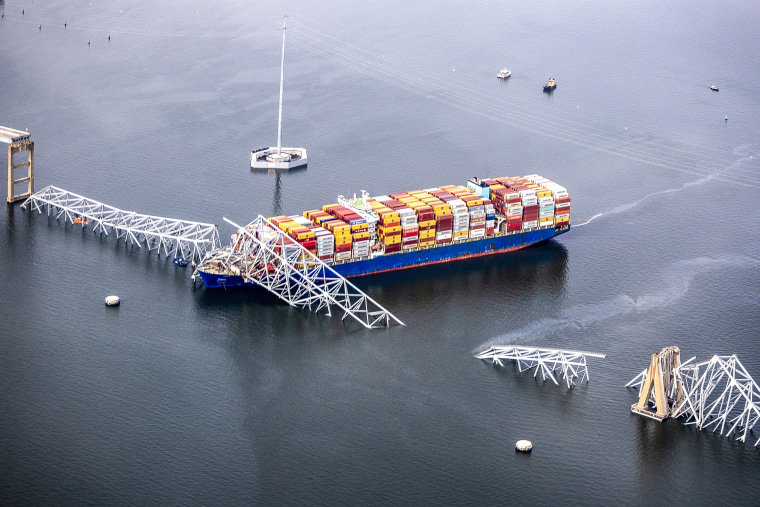
Writer David Simon, a champion of Baltimore who set his TV crime drama "The Wire" on the streets of the city he once covered as a reporter, warned online that the people who will suffer the most are those whose livelihoods depend on the port.
"Thinking first of the people on the bridge," Simon posted on X . "But the mind wanders to a port city strangling. All the people who rely on ships in and out."
Timeline of crash
Dramatic video captured the moment at 1:28 a.m. Tuesday when the Dali struck a support and sent the bridge tumbling into the water. A livestream showed cars and trucks on the bridge just before the strike. The ship did not sink, and its lights remained on.
Investigators said in a timeline that the Dali's lights suddenly shut off four minutes earlier before they came back on and that then, at 1:25 a.m. dark black smoke began billowing from the ship's chimney.
A minute later, at 1:26 a.m., the ship appeared to turn. And in the minutes before it slammed into the support, the lights flickered again.
Maryland Transportation Secretary Paul Wiedefeld said the workers on the bridge were repairing concrete ducts when the ship crashed into the structure.
At least seven workers were pouring concrete to fix potholes on the roadway on the bridge directly above where the ship hit, said James Krutzfeldt, a foreman.
Earlier, the Coast Guard said it had received a report that a “motor vessel made impact with the bridge” and confirmed it was the Dali, a containership sailing under a Singaporean flag that was heading for Sri Lanka.
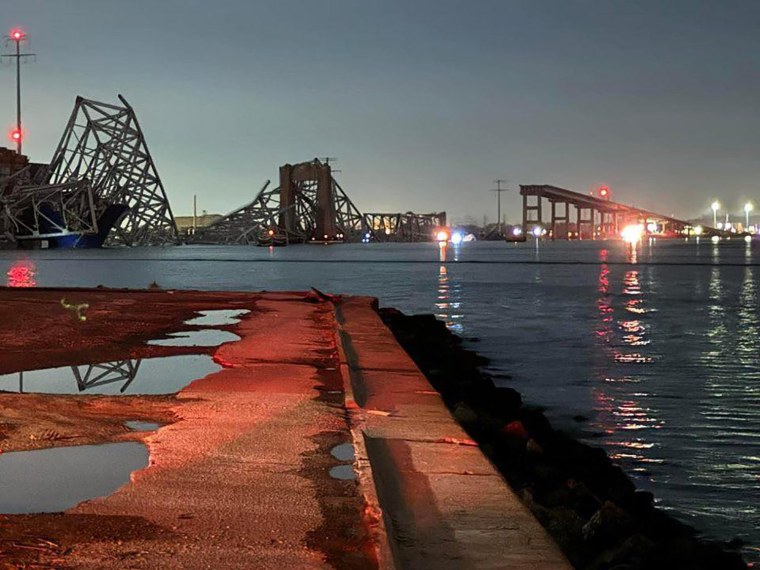
Bobby Haines, who lives in Dundalk in Baltimore County, said he felt the impact of the bridge collapse from his house nearby.
"I woke up at 1:30 this morning and my house shook, and I was freaking out," he said. "I thought it was an earthquake, and to find out it was a bridge is really, really scary."
Families of bridge workers wait for updates
Earlier in the day, relatives of the construction crew waited for updates on their loved ones.
Marian Del Carmen Castellon told Telemundo her husband, Miguel Luna, 49, was working on the bridge.
“They only tell us that we have to wait and that they can’t give us information,” she said.
Castellon said she was "devastated, devastated because our heart is broken, because we don’t know how they have been rescued yet. We are just waiting for the news."
Luna's co-worker Jesús Campos said he felt crushed, too.
“It hurts my heart to see what is happening. We are human beings, and they are my folks,” he said.
Campos told The Baltimore Banner that the missing men are from El Salvador, Guatemala, Honduras and Mexico.
Active search and rescue ends
The Coast Guard said it was suspending the active search-and-rescue effort at 7:30 p.m. Tuesday.
"Coast Guard’s not going away, none of our partners are going away, but we’re just going to transition into a different phase," Gilreath said at a news conference.
Maryland State Police Superintendent Roland L. Butler, Jr., said it was moving to a recovery operation. Changing conditions have made it dangerous for divers, he said.
Butler pledged to "do our very best to recover those six missing people," but the conditions are difficult.
"If we look at how challenging it is at a simple motor vehicle crash to extract an individual, I'm sure we can all imagine how much harder it is to do it in inclement weather, when it's cold, under the water, with very limited to no visibility," he said.
"There's a tremendous amount of debris in the water," which can include sharp metal and other hazards, and that could take time, Butler said.
'A long road in front of us'
Built in 1977 and referred to locally as the Key Bridge, the structure was later named after the author of the American national anthem.
The bridge is more than 8,500 feet long, or 1.6 miles. Its main section spans 1,200 feet, and it was one of the longest continuous truss bridges in the world upon its completion, according to the National Steel Bridge Alliance .
About 31,000 vehicles a day use the bridge, which equals 11.3 million vehicles per year, according to the Maryland Transportation Authority.
The river and the Port of Baltimore are both key to the shipping industry on the East Coast, generating more than $3.3 billion a year and directly employing more than 15,000 people.
Asked what people in Baltimore can expect going forward, the state's transportation secretary said it is too early to tell.
"Obviously we reached out to a number of engineering companies, so obviously we have a long road in front of us," Wiedefeld said.
Julia Jester reported from Baltimore, Patrick Smith from London, Corky Siemaszko from New York and Phil Helsel from Los Angeles.
Julia Jester is a producer for NBC News based in Washington, D.C.
Patrick Smith is a London-based editor and reporter for NBC News Digital.
Phil Helsel is a reporter for NBC News.
Corky Siemaszko is a senior reporter for NBC News Digital.
Baltimore bridge collapse latest: Six missing workers 'presumed dead'; satellite images reveal scale of bridge damage
Officials say they are transitioning from a search and rescue mission to a recovery operation "based on the length of time" and the "temperature of the water".
Wednesday 27 March 2024 00:36, UK
Please use Chrome browser for a more accessible video player
- Major bridge collapses in Baltimore after being struck by a cargo ship
- Six people still missing as two pulled from water
- Company says six workers are presumed dead
- Ship issued mayday before crash | Vessel appeared to lose power and start smoking
- Video of collapse | Satellite images reveal scale of damage
- Dali vessel involved in separate incident in 2016
- What is this bridge?
- Listen: Expert view on the Baltimore bridge collapse
Thank you for following along.
You can scroll down to catch up on the latest updates as happened during the day.
We'll be back with more news tomorrow.
Officials say they are transitioning from search and rescue operation to a recovery operation.
US Coast Guard and Maryland State Police officials say that based on the frigid temperature of the water and the length of time that had elapsed since the bridge came down there was little if any chance that the six missing could be found alive.
Maryland's senator has praised the work of first responders, saying their heroism is a "ray of light on this dark day".
Emergency workers managed to stop traffic along the Francis Scott Key Bridge after the Dali container ship put out a mayday call.
Chris Van Hollen said their actions "saved lives" and he was "thankful for them".
A team of construction workers were repairing potholes along the bridge at the time it collapsed.
Eight people were initially reported missing, but two people were found, with one suffering serious injuries.
A short while ago, we heard from the executive vice president of construction company Brawner Builders, who confirmed the six workers still unaccounted for are presumed dead.
Six workers missing after the Baltimore bridge collapsed are presumed dead, the executive vice president of Brawner Builders has confirmed.
Jeffrey Pritzker told our US partner site NBC News that there was one survivor.
The company is not releasing names at this time.
Eight people, who were working on the bridge at the time it was struck by the Dali cargo ship, were initially reported missing.
Two of them were found, with one suffering serious injuries.
The other six have been missing for more than 12 hours.
Maryland's emergency management department has raised its state activation level.
It is now registered as 'full' - meaning an incident has occurred that may require significant resources.
As a result, the state's emergency operations centre has been "fully staffed".
The state's activation levels change based on a variety of factors.
The most influential factor is the occurrence of a significant incident, which is a term used to describe a single or multi-jurisdictional incident.
A construction worker has said he was told his missing colleagues were on a break when the Dali ship crashed into the Baltimore bridge.
Jesus Campos told the AP news agency some members of staff were sitting in their trucks when the bridge collapsed.
The Brawner Builders employee said he learned about the disaster from a co-worker and immediately worried about colleagues he knew were working on the bridge.
"When he told me that, they came to mind and I was praying to God that nothing had happened to them," he added.
"It is so hard for me to describe. I know that a month ago I was there, and I know what it feels like when the trailers pass.
"Imagine knowing that it is falling. It is so hard, one would not know what to do," he said.
One person involved in the Baltimore bridge collapse has been discharged from hospital, an official at the R Adams Cowley Shock Trauma Centre has told AP.
Dr David Efron did not comment on the nature of the patient's injuries, and the hospital has not released their name.
Eight people were initially reported missing after the collapse.
Two people have been found - one was said to have serious injuries, while the other did not require hospital treatment.
Search and rescue operations are continuing this evening to find the six construction workers still missing.
The US transportation secretary has said the path to rebuilding the collapsed Baltimore bridge will not be quick or easy.
Pete Buttigieg described the bridge as "one of the cathedrals of American infrastructure".
"It has been part of the skyline for this region for longer than many of us have been alive," he said.
He has also taken the time to thank first responders and offered comfort to those "who woke up today to the news that no one wants to receive".
"This is an excruciating day for several families," he said.
Clearer satellite images have emerged of the moment the Dali container ship hit the Francis Scott Key Bridge.
The vessel crashed into the structure after issuing a mayday call and losing power.
Earlier, Maryland governor Wes Moore said the ship was travelling at a speed of eight knots at the time it sent out its distress call.
Within minutes of departure on Tuesday, the faltering container ship crashed into the Francis Scott Key Bridge.
Here is a timeline of the Singapore-flagged vessel's collision, in local time (four hours behind British time).
1.04am: Loaded with shipping containers, Dali departs from Baltimore's port, heading to Colombo, Sri Lanka.
1.24am: Dali slowly approaches the Key Bridge, according to video captured by StreamTime Live.
1.24am and 33 seconds: The ship appears to suffer a total power failure as all its lights go out.
1.25am and 31 seconds: About a minute later, the ship's lights flicker back on. Black smoke starts rising from somewhere aboard the ship.
1.26am and 37 seconds: The ship's lights go dark again.
1.27am: Dali appears to be colliding with one of the Key Bridge's piers. The US Coast Guard receives the first report of a collision.
1.27am and 10 seconds: The ship's lights come back on.
1.28am and 48 seconds: The roadway of the Key Bridge begins collapsing.
1.29am: Most of the bridge's span has plunged beneath the water.
1.40am: Baltimore City Fire Department has dispatched rescue teams for the Patapsco River, with reports of multiple people in the water.
1.50am: The first fire unit arrives on the scene.
Be the first to get Breaking News
Install the Sky News app for free


IMAGES
COMMENTS
You can call us anytime and we will repair water damage to your Fort Lauderdale yacht. We serve the Broward area, and can be called upon for custom jobs in Miami-dade, and Palm Beach counties. Custom Marine Carpentry, Fort Lauderdale yacht carpenter, yacht carpentry services. boat air conditioning leak, call Dennis Boatworks to repair the water ...
The repair yard likely operates with full waterfront overhead and needs to charge $85 to $100 per hour for their work. If the boat is to be moved elsewhere, that adds cost to any other yard's estimate. The owner wants the boat repaired to the way it was just before the damage occurred, or may even want the boat to be totalled if it seems like ...
5. Take A Sea Trial. The most effective way to determine if a boat has water damage is to take it out on the water and test its functions. If a boat takes longer than usual to get up and plane, or it struggles to maintain speed, it could indicate water damage. Also, pay close attention to any strange noises or vibrations, which may suggest that ...
Document the damage. Take photos of your damaged vessel with a smartphone or camera. If your boat has struck another vessel, also document the damage to the other vessel, and remember to obtain the other party's contact and insurance information, and hull identification number (HIN#), if possible. Contact a professional repair company or marina.
A few signs of potential yacht water damage include: minor blistering or bubbling of surfaces in the structure of the yacht; excessive mildew odor inside or on deck; salty buildup on surfaces inside; Your yacht is important to you- always be on the lookout for water damage.
Boat water damage can occur through various mechanisms, including the devastating force of hurricanes and more common scenarios. During hurricanes, intense winds and torrential rains can breach seals, hatches, or covers, allowing water to infiltrate the interior. Other factors to consider are powerful waves and storm surges can submerge vessels ...
Boat water damage can manifest through various mechanisms, ranging from the destructive force of hurricanes to more commonplace scenarios. In the case of hurricanes, the formidable combination of…
As a full-service yacht care team, we specialize in multiple aspects including water damage and flood restoration. Water is a powerful element and can saturate furniture, drapes, carpets, vinyl and fabric wall coverings, wood and other surfaces leaving the interior of your boat look unappealing and in need of a makeover.
Water or flood damage can be devastating if the upholstery is not quickly and professionally dried. We will assess whether cleaning can help or whether you need to replace soaked furniture, mattresses, bedding, and other fabric surfaces. ... For immediate response after water damage, call Mega Yacht Cleaning at (954) 448-8899. We offer free ...
Essentially the process is to remove the damaged area, dry it if required and replace the material. This is easy if it is six inches of accessible deck, but is a massive undertaking if the damage is half of the hull. For vessels with a large area of compromised core, a common owner's fix has been to drill hundreds of holes in the affected ...
Apr 30, 2013. Owners and insurance companies sell a wave of damaged boats soon after a major storm hits the coast. These boats can a bargain for those with the skills and resources to repair them, but they also can be the proverbial "hole in the water" waiting to be filled with money, sweat and lost hopes.
Water damage in a home can be a nightmare and water damage on a yacht is even worse. Today I help a long time friend on how to fix water stains from damaged ...
In summary, salt water can damage boats, and boat owners should be aware of the extent of the damage caused by saltwater exposure. To prevent this damage, boat owners need to take appropriate measures such as washing the boat thoroughly each time it is used, using protective coatings and paints, and maintaining their boats correctly.
Ed shows how to do a quick and inexpensive repair to water damaged teak on our Hatteras Yacht.Find us onhttps://www.facebook.com/Trying-Not-To-Sink-134738576...
Hi all, We are looking at a 1996 Oyster 55 to buy. She seems structurally sound but shabby and neglected. There are many areas where the woodwork is water damaged around the portholes and in the galley.The décor is cherry, and where it is water damaged it is blackened with white edges. Obviously the first job would be to find the source of the leak (looks to be leaky portholes) and fix it/them.
Yacht Salvage. Rhode Island: (401) 732-6300 Massachusetts: (508) 478-0200 South Carolina: (843) 563-9199. Visit the Contact page for complete details.
The Group of, Seven Star Care Services, Quick Links. Water Damage Restoration / Odour Control / Mould Remediation / Repairs. Water Extraction. Drying Process. 1300 07STAR / 1300 077827 / 0421 374 036.
A watermaker on a yacht converts seawater into fresh water through a process known as reverse osmosis (RO). A high-pressure pump pushes seawater through a semi-permeable membrane that filters out salt, organics, and bacteria. The fresh water is pumped into your water tanks while the remaining brine bi-product is discharged over the side of the ...
Team Water Damage is a 35' (10.67m) High Performance Sport Yacht built by BAJA and delivered in 2007. Photos and specifications available below. Find yachts and boats listed for sale and ones off the market in our YATCO Yacht & Boat Directory. This web page provides historical yacht information for reference purposes only.
A crew member on the DALI cargo ship sent a message hours after the Francis Scott Key Bridge collapsed Tuesday saying everybody on board was safe, according to Apostleship of the Sea director Andy ...
The bodies of two of the construction workers who died after a 984-foot-long cargo ship hit a pillar of Baltimore's Francis Scott Key Bridge have been recovered, officials said Wednesday.
The owner of the ship that rammed into a Baltimore bridge could face hundreds of millions of dollars in damage claims after the accident sent vehicles plunging into the water and threw the eastern ...
The container ship Dali, owned by Grace Ocean PTE, rests against wreckage of the Francis Scott Key Bridge in the Patapsco River on Wednesday, March 27, 2024, as seen from Pasadena, Md. Investigators began collecting evidence Wednesday from the cargo ship that plowed into Baltimore's Francis Scott Key Bridge and caused its collapse, while in the waters below divers searched through twisted ...
The Francis Scott Key Bridge was opened in 1977 and carried more than 12.4 million vehicles last year. The bridge was one of the three major ways to cross the Patapsco River and formed part of ...
Studies show that both surface water and groundwater in Moscow are polluted. Russia is rich in water, boasting 2 million lakes, 210,000 rivers, and a quarter of the earth's freshwater reserves. Despite the country's bountiful resources, access to clean water is an issue in many towns and cities. Rampant Soviet-era pollution dirtied Russia's major waterways, […]
The Philippines and China have reported several maritime run-ins in recent months, which included the use of water cannon. The two countries have long faced off near the disputed reefs in the vast ...
The cost of water damage restoration depends on the size of the home, the type of water event and the extent of the water damage. On average, expect to pay between $1,500 and $6,000 for water ...
EYEPRESS via Reuters. KYIV, Ukraine — Ukraine executed its most brazen attack into Russian territory in the nine-month-old war on Monday, targeting two military bases hundreds of miles inside ...
The Francis Scott Key bridge in Baltimore, Maryland, partially collapsed early Tuesday, police said. It was hit by a ship, officials said.
1.29am: Most of the bridge's span has plunged beneath the water. 1.40am: Baltimore City Fire Department has dispatched rescue teams for the Patapsco River, with reports of multiple people in the ...